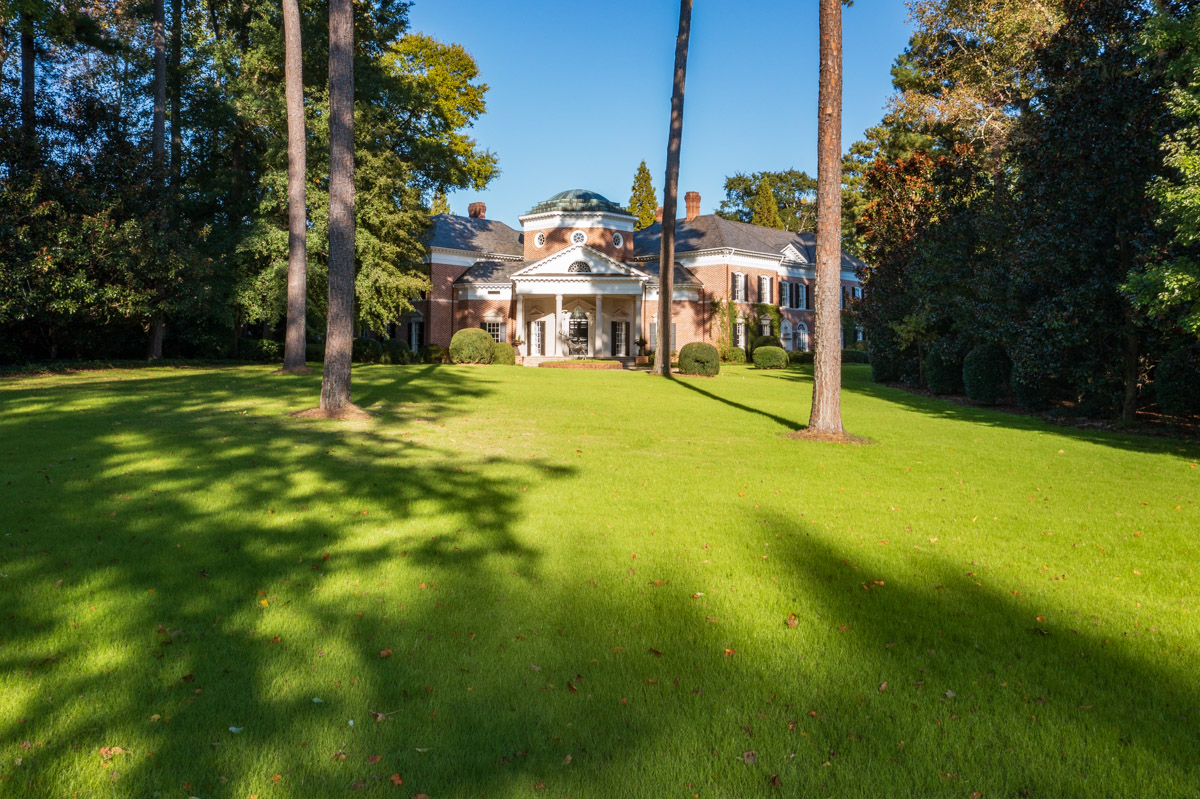
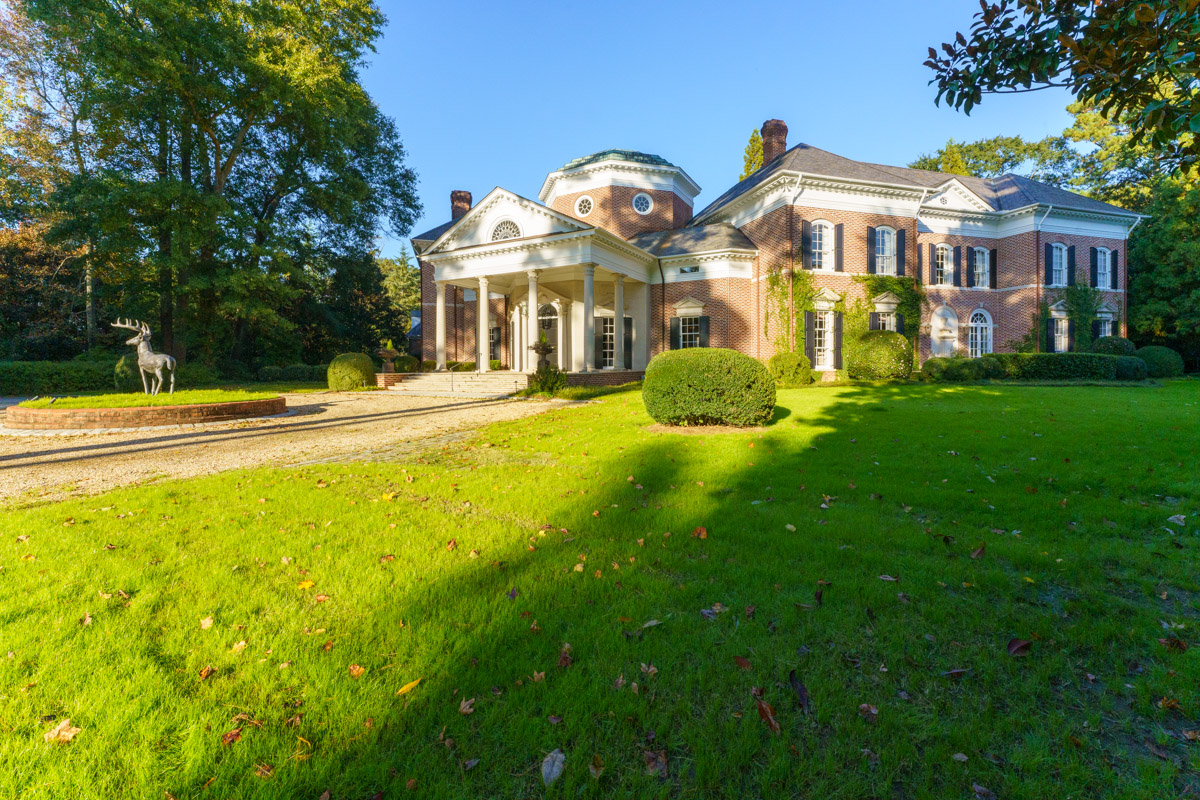
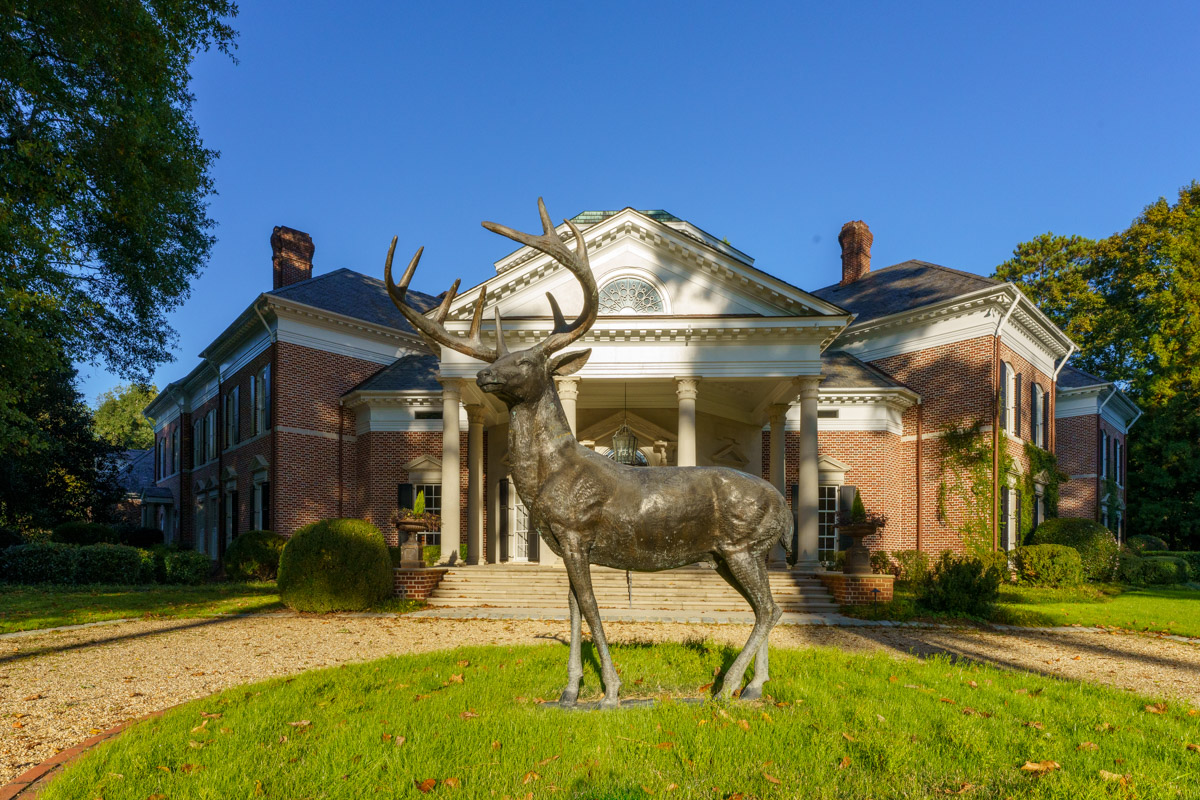
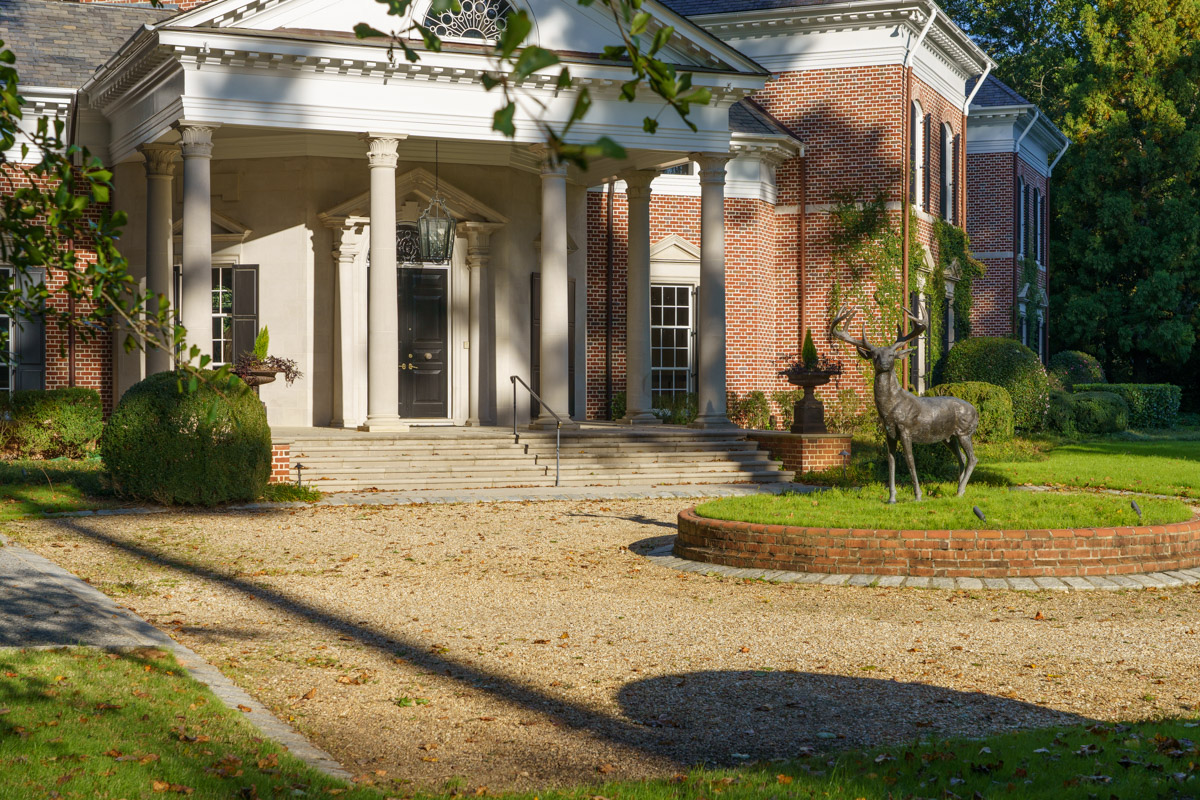

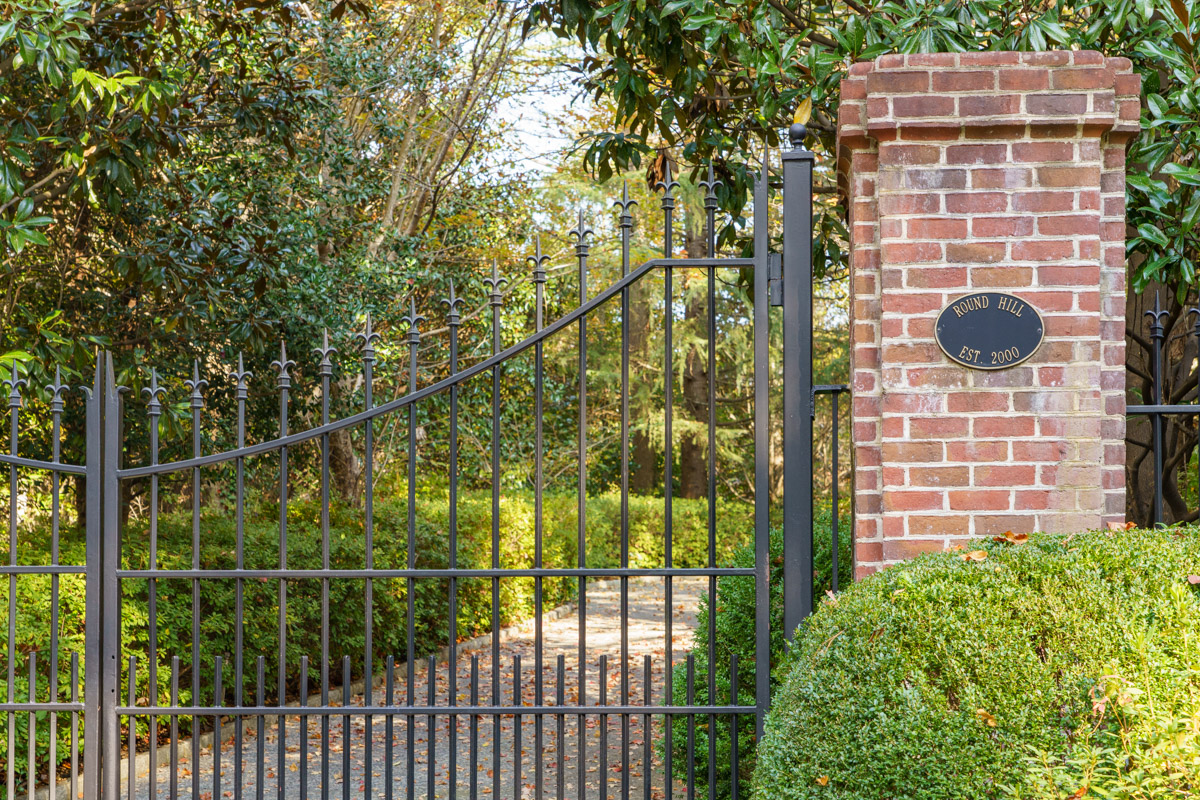
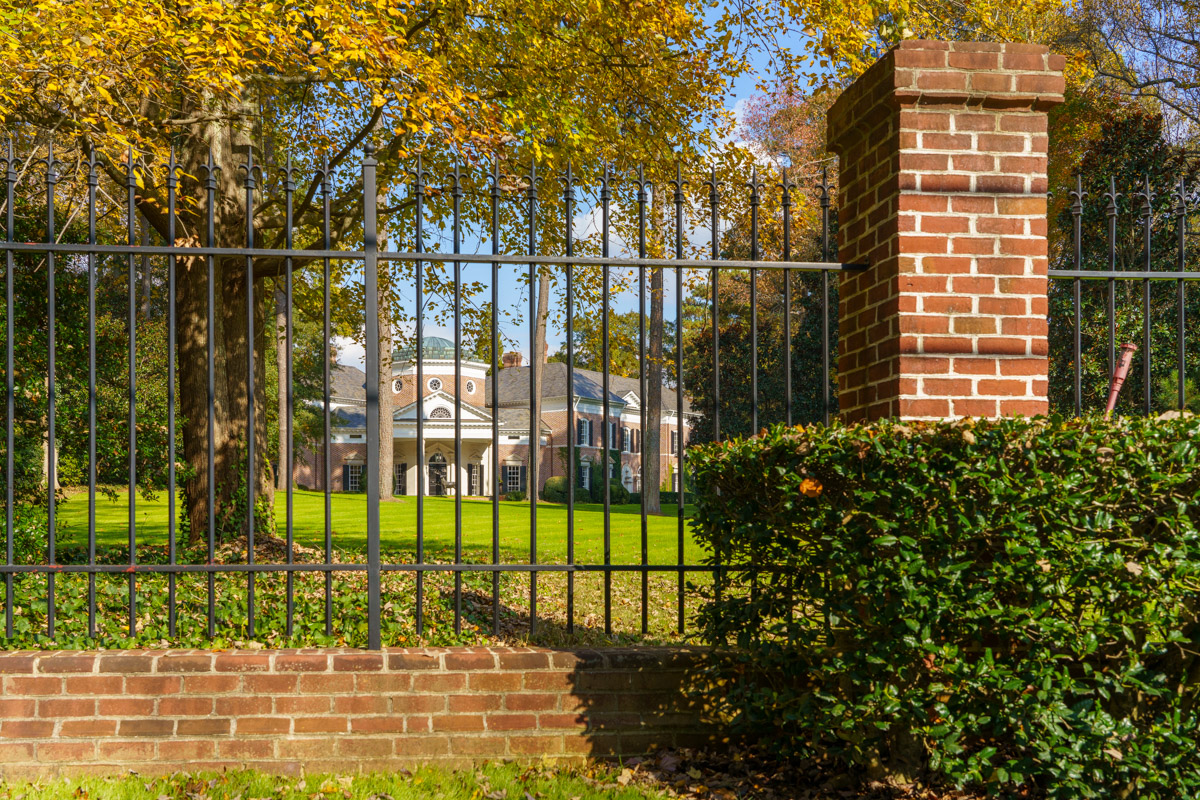
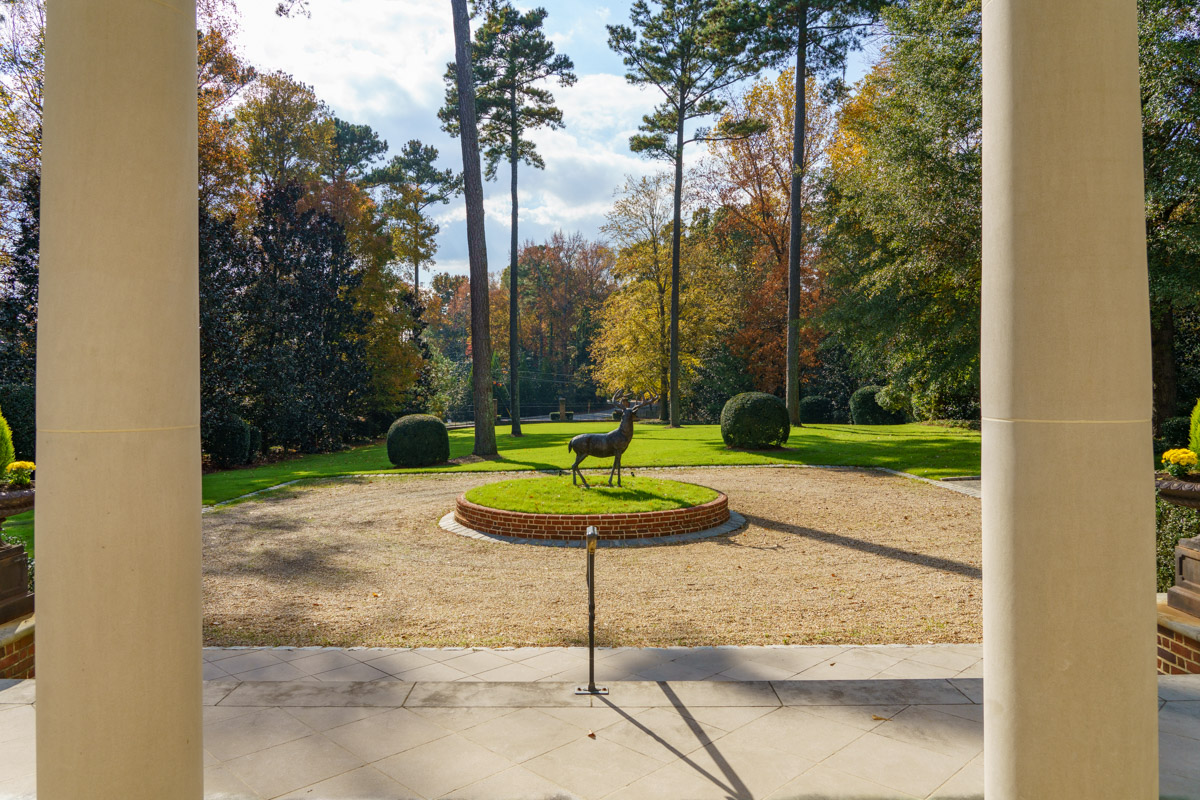
Your imagination is the only limit to what you can create at this amazing estate! The 14+ acres and stunning home at 825 Davis Drive is the largest property available in the Buckhead area! Home of the late Charlie Loudermilk, a business leader and civic legend in the community, this fully fenced and gated property is being offered for sale for the first time.








The centerpiece of the estate is the regal 15,000 square foot home whose iconic facade is visible across a long lawn from the corner of Davis and Northside Drive. The home was designed by William T. Baker with significant influence from Thomas Jefferson’s Monticello in Virginia, and built in 1999 by Jerry Bonnor with the highest quality standards.
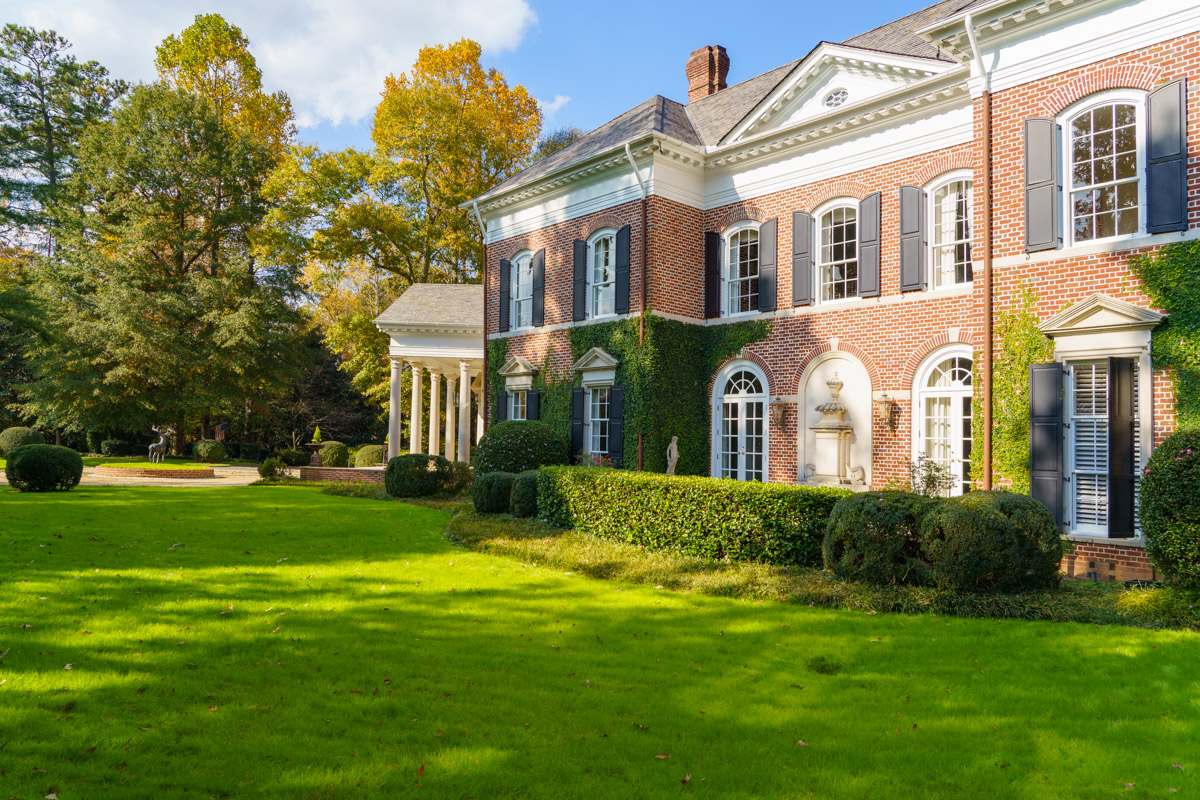

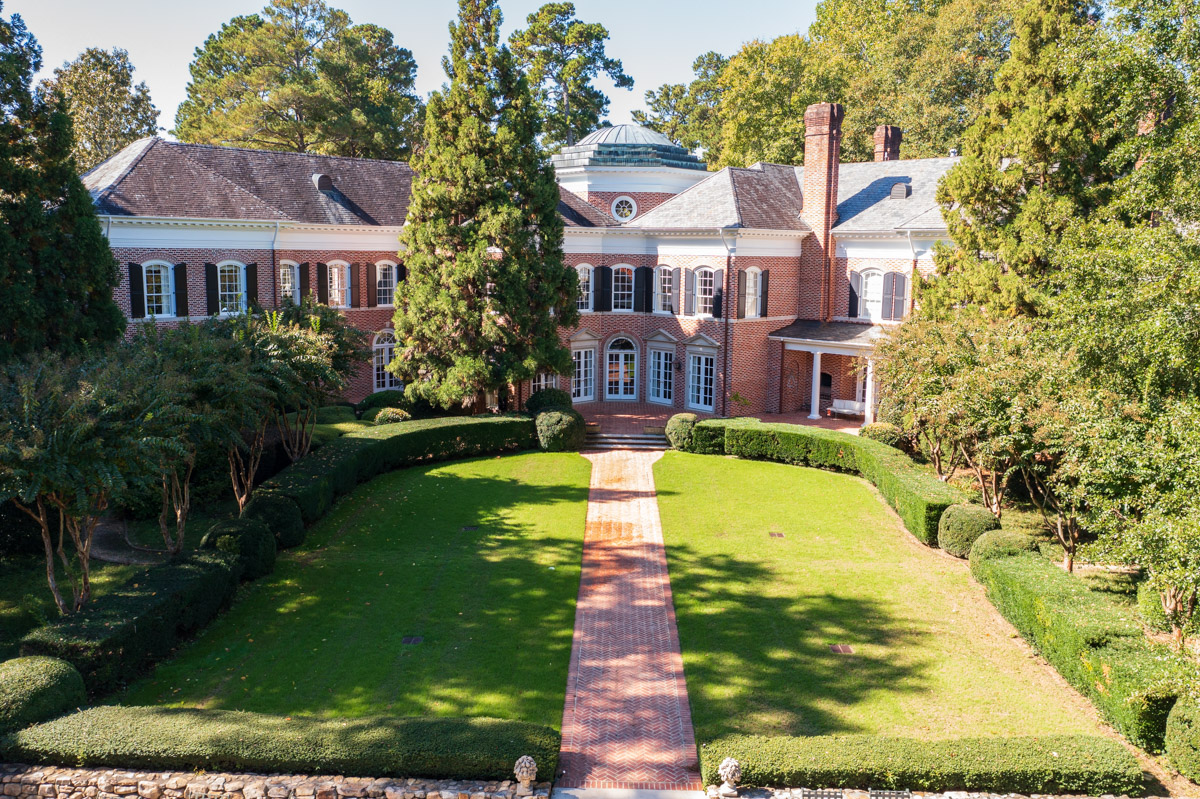
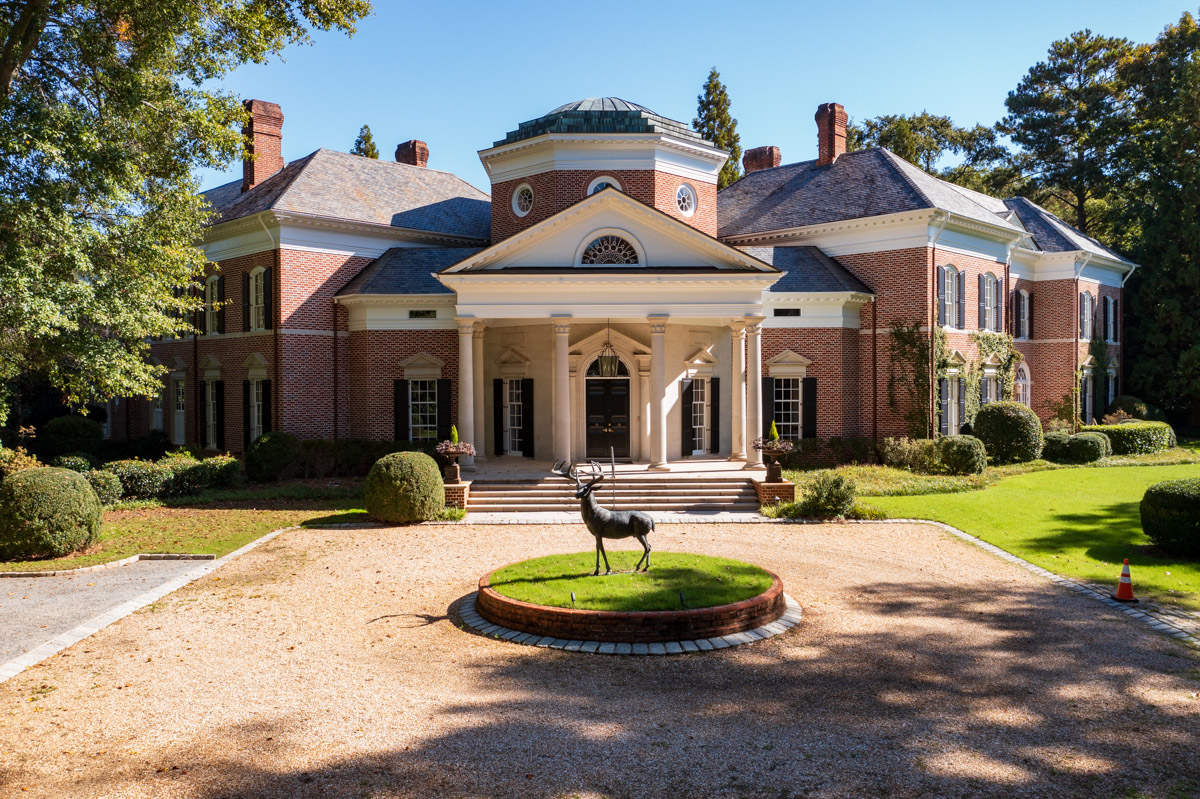
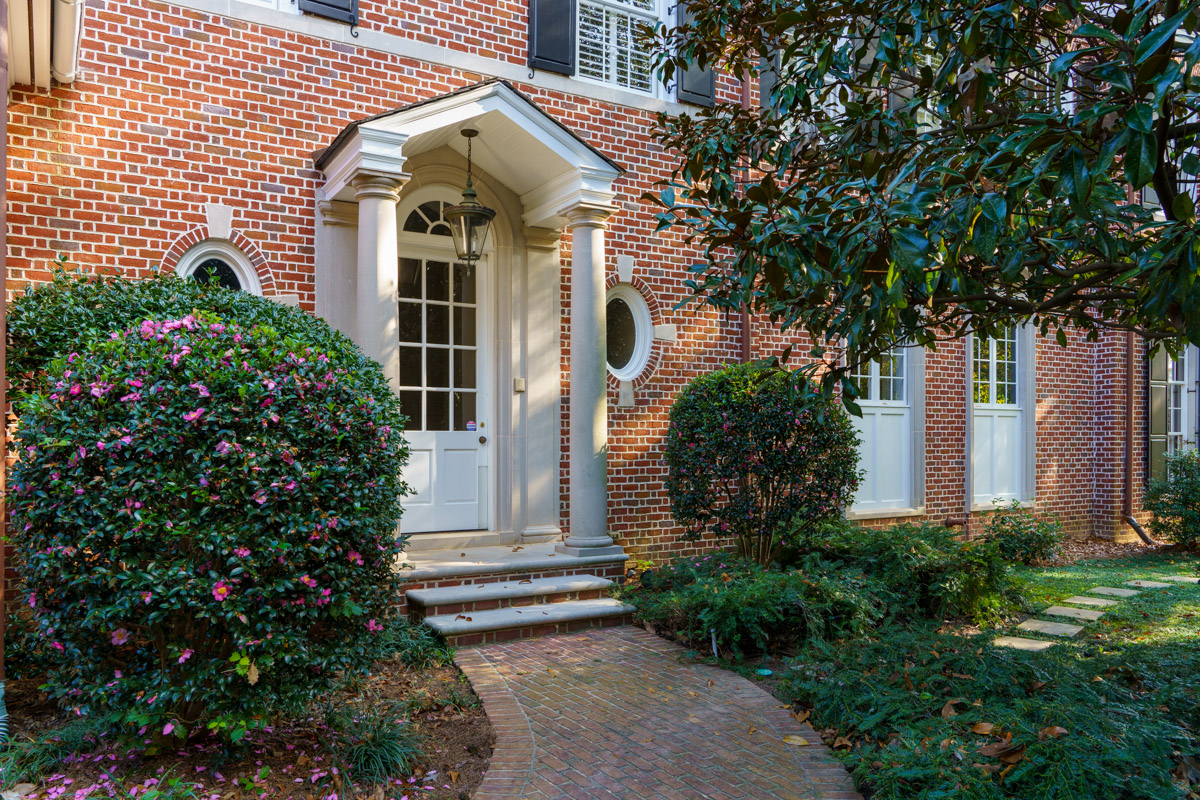


The grounds include 14+ usable acres with no floodplain. A formal entrance enters on Davis Drive and a staff entrance is accessible from Northside Drive. This property and all surrounding properties are zoned for 2-acre minimum lot size, providing options for developing portions of the land for investment in the future if desired. Paths winding through the wooded property connect various improvements that include a fishing pond, waterfall, greenhouse, raised garden beds, an old log cabin that was once a hunting lodge, and and a barn.
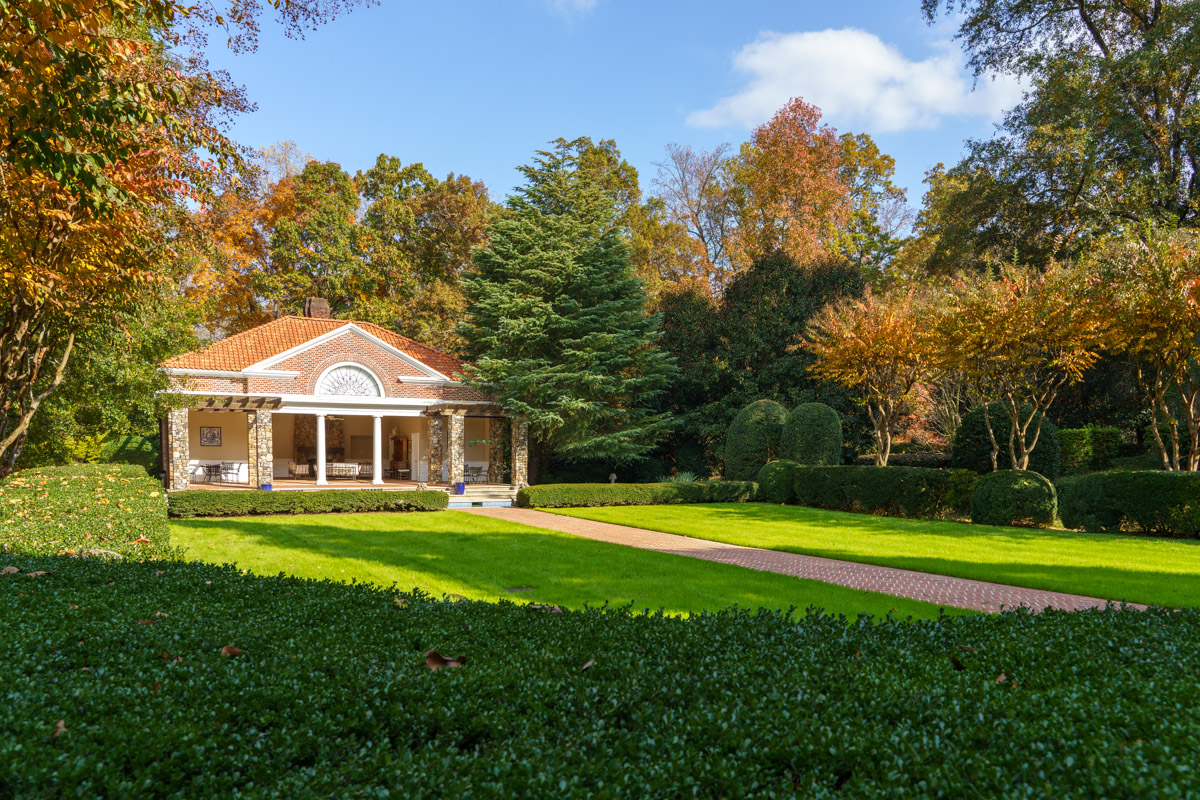


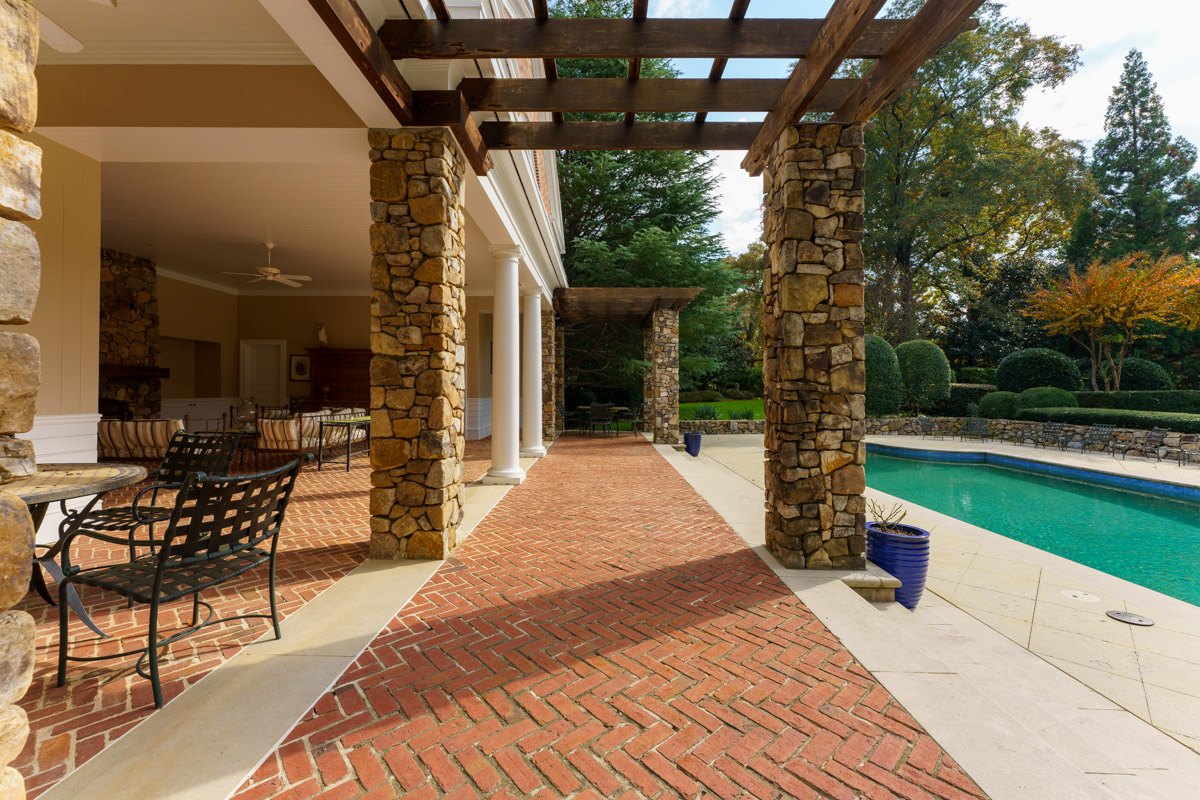
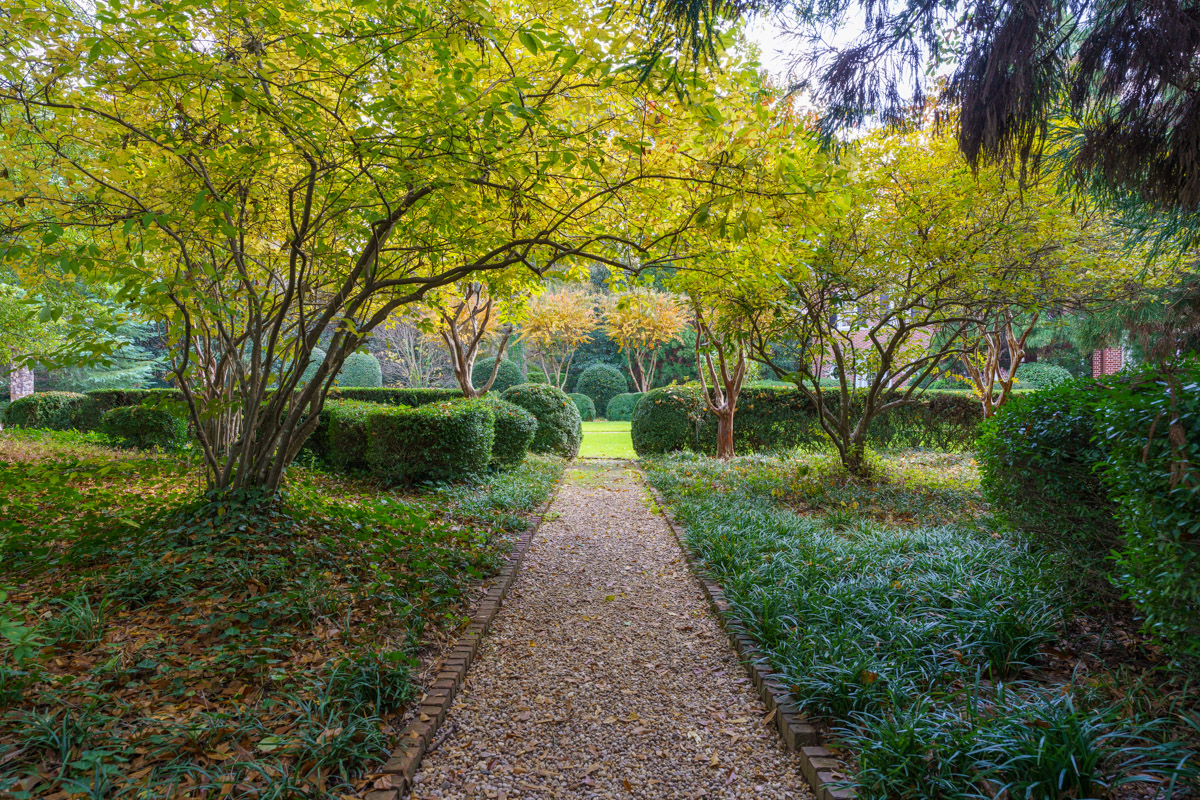
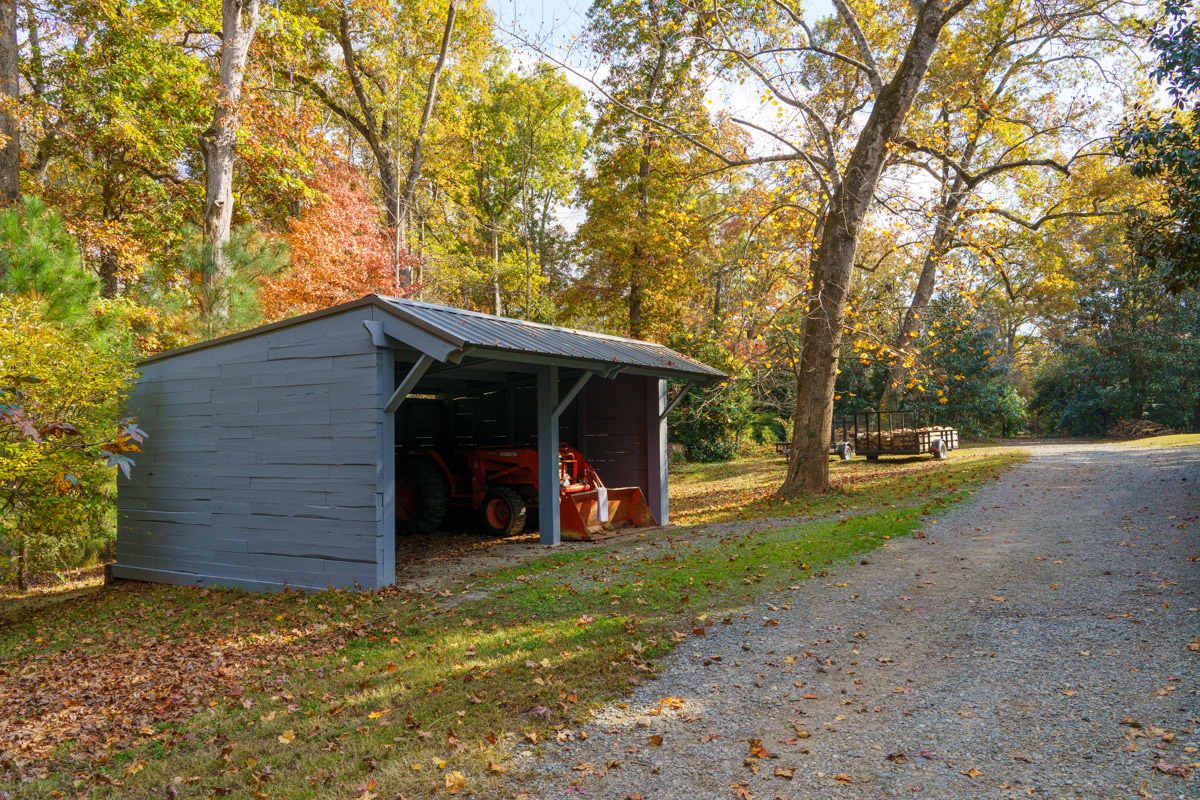
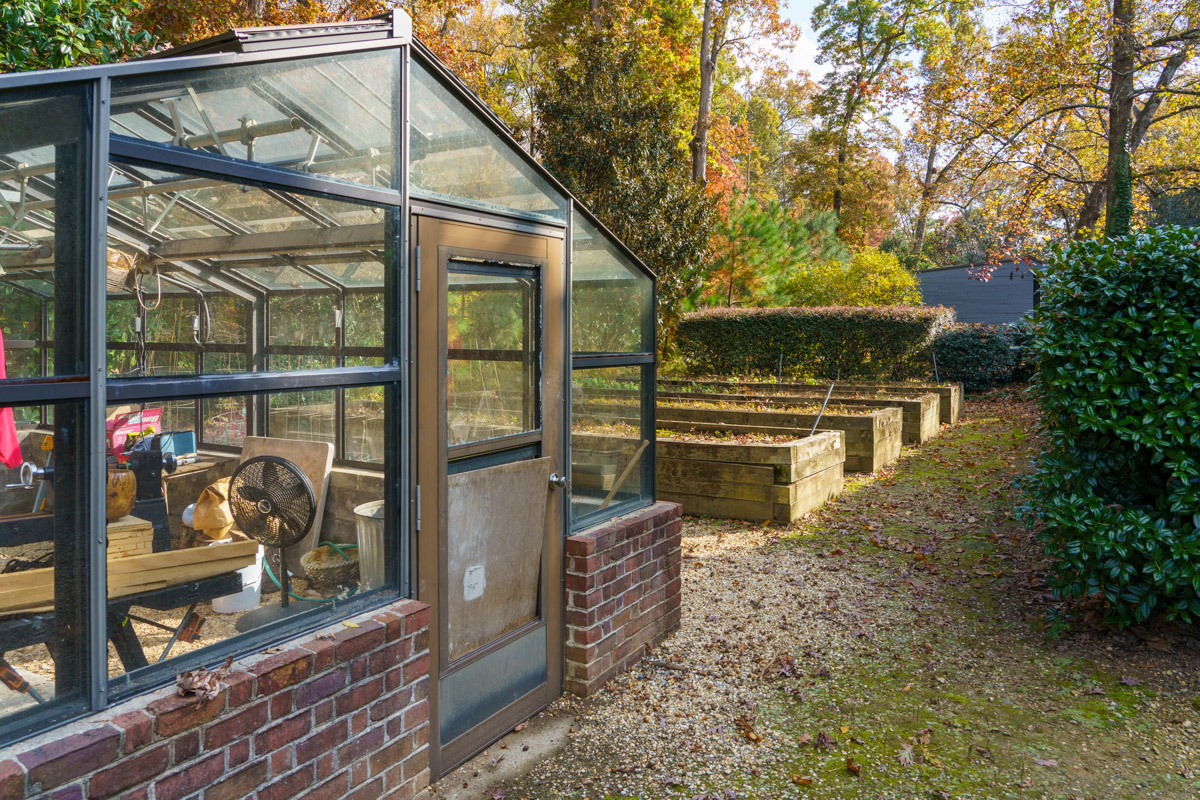
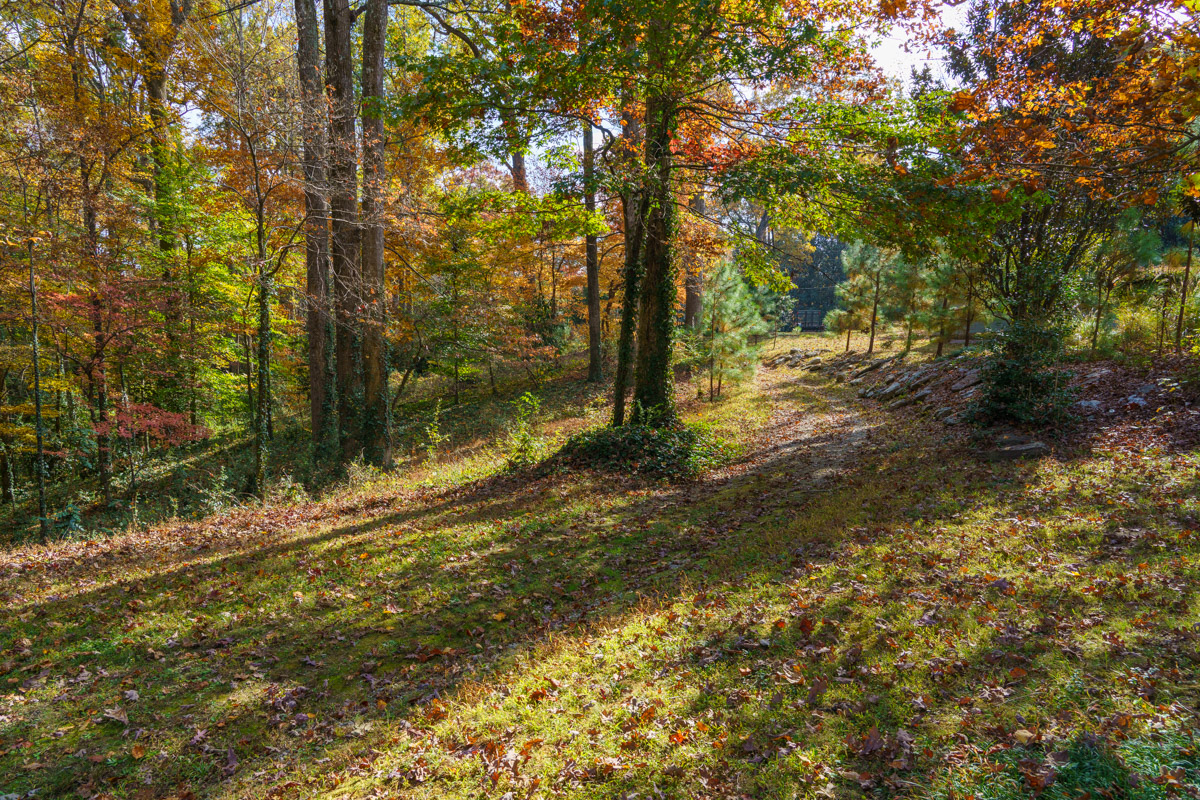
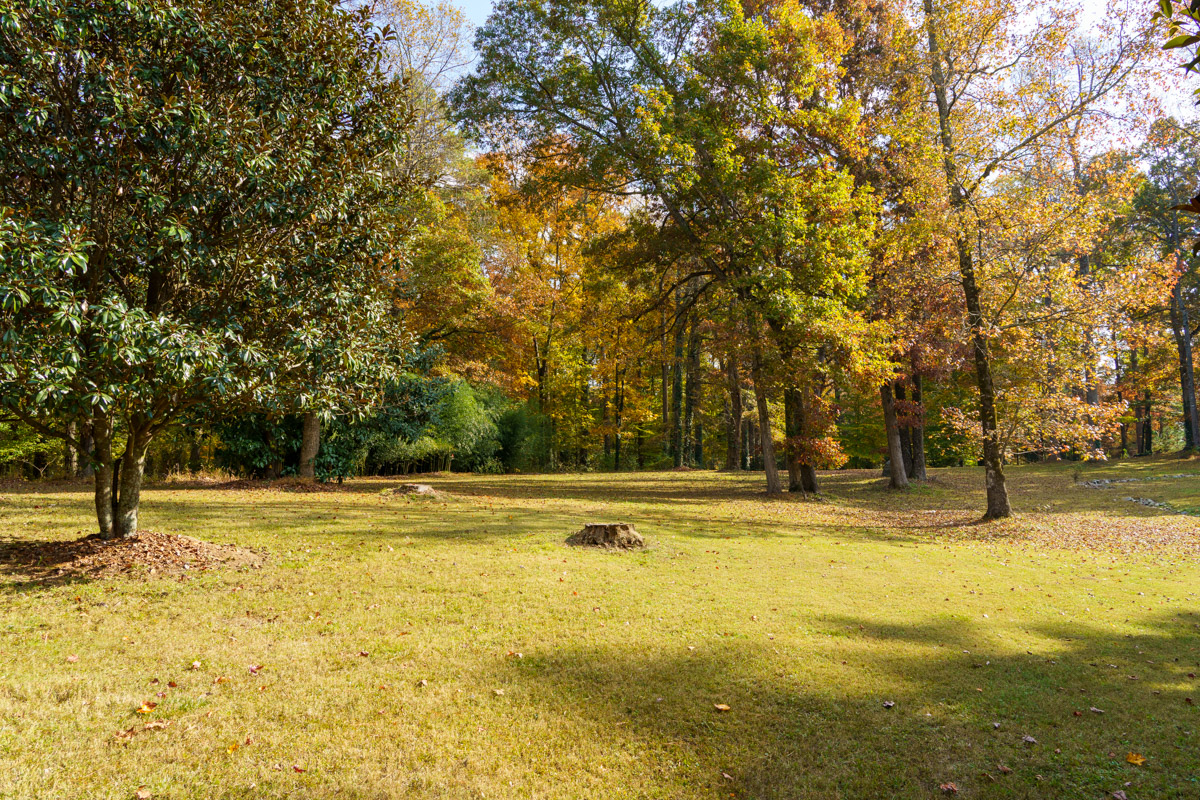


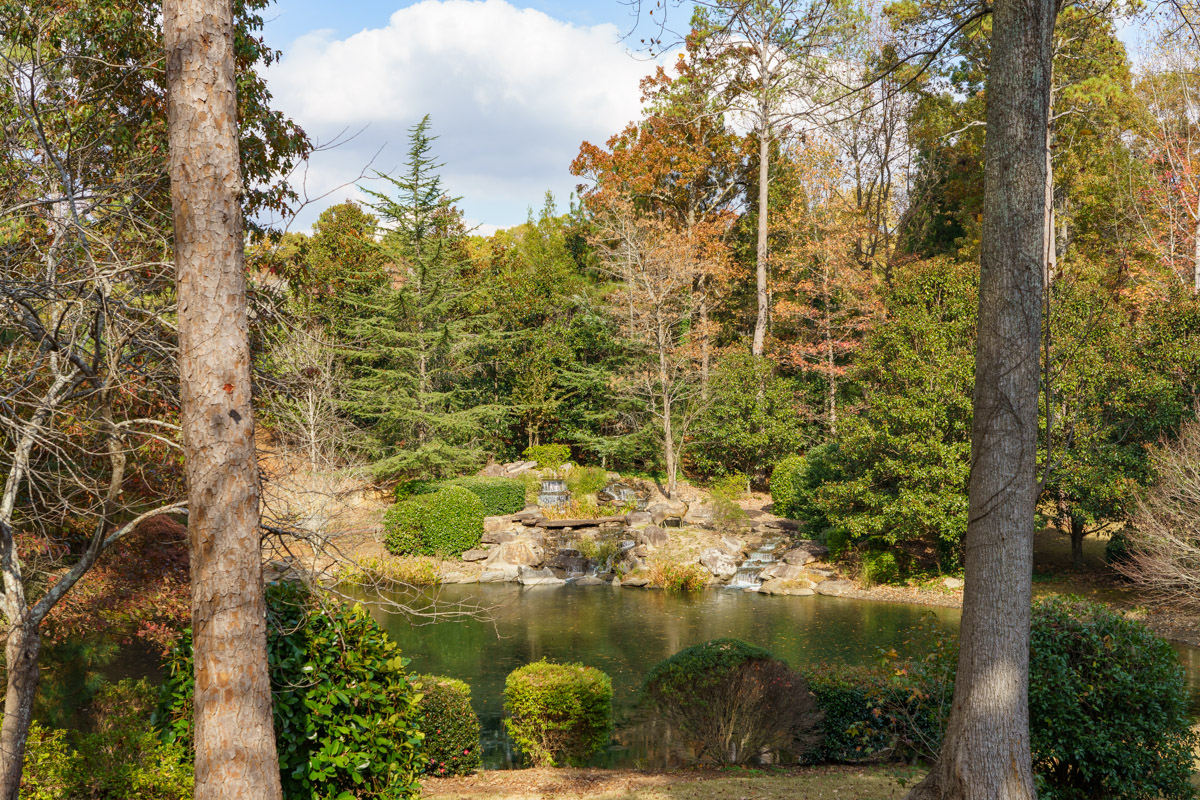
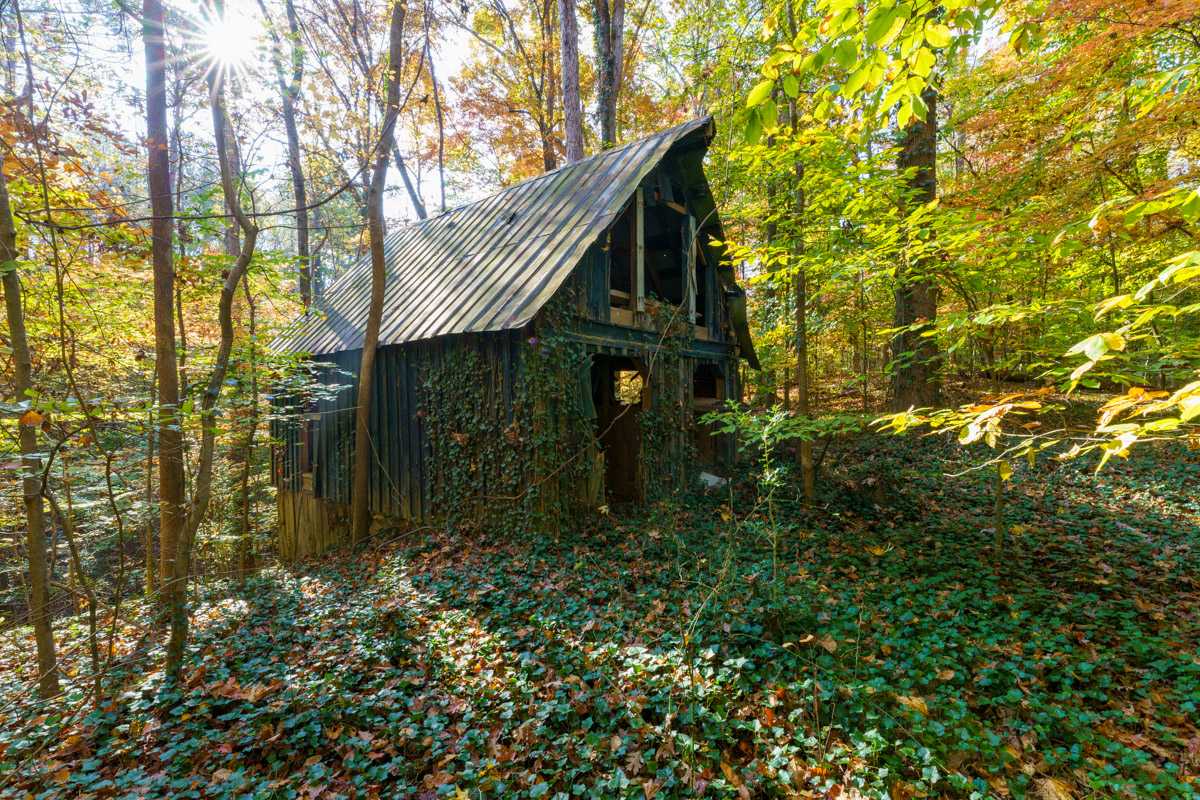
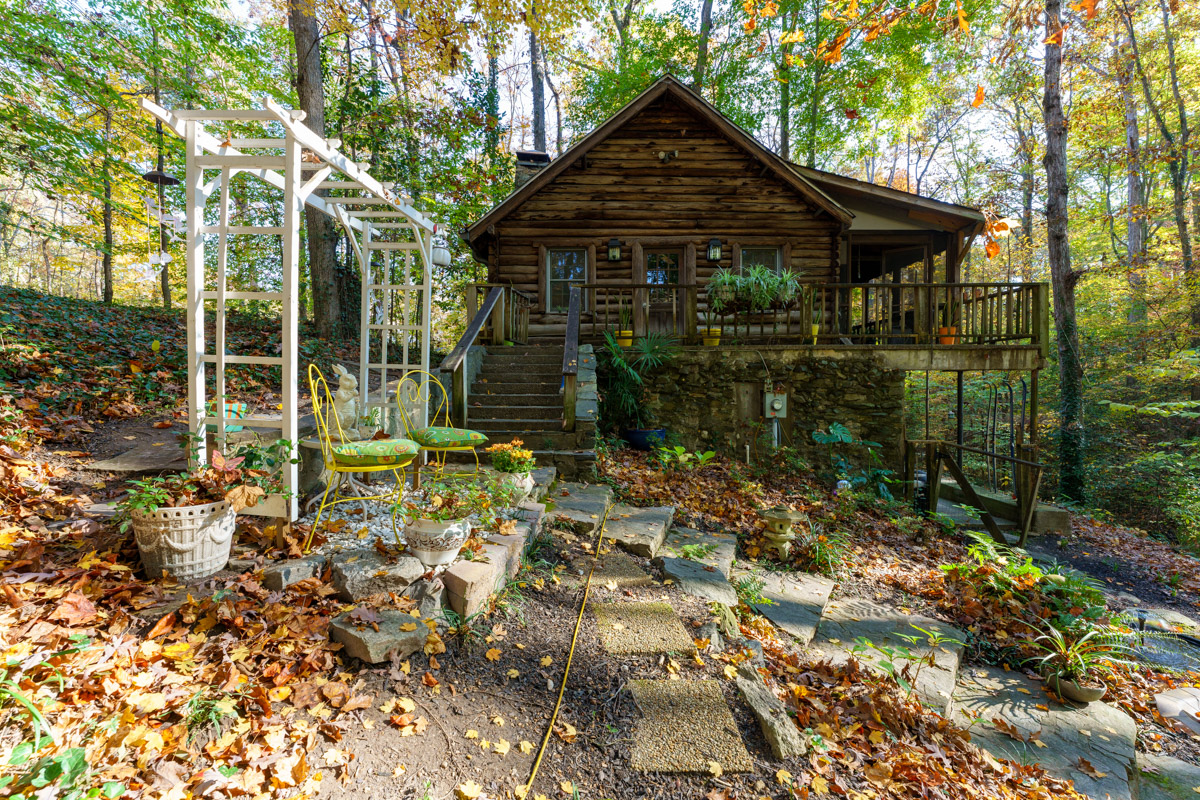
The approach to the main entrance along the winding driveway is quite an experience. The home reveals itself suddenly as you round the corner. The classically-styled entrance is framed by oversized columns and a grand staircase, surrounded by generous quantities of hand-carved limestone, and crowned by a copper rotunda and Vermont slate.
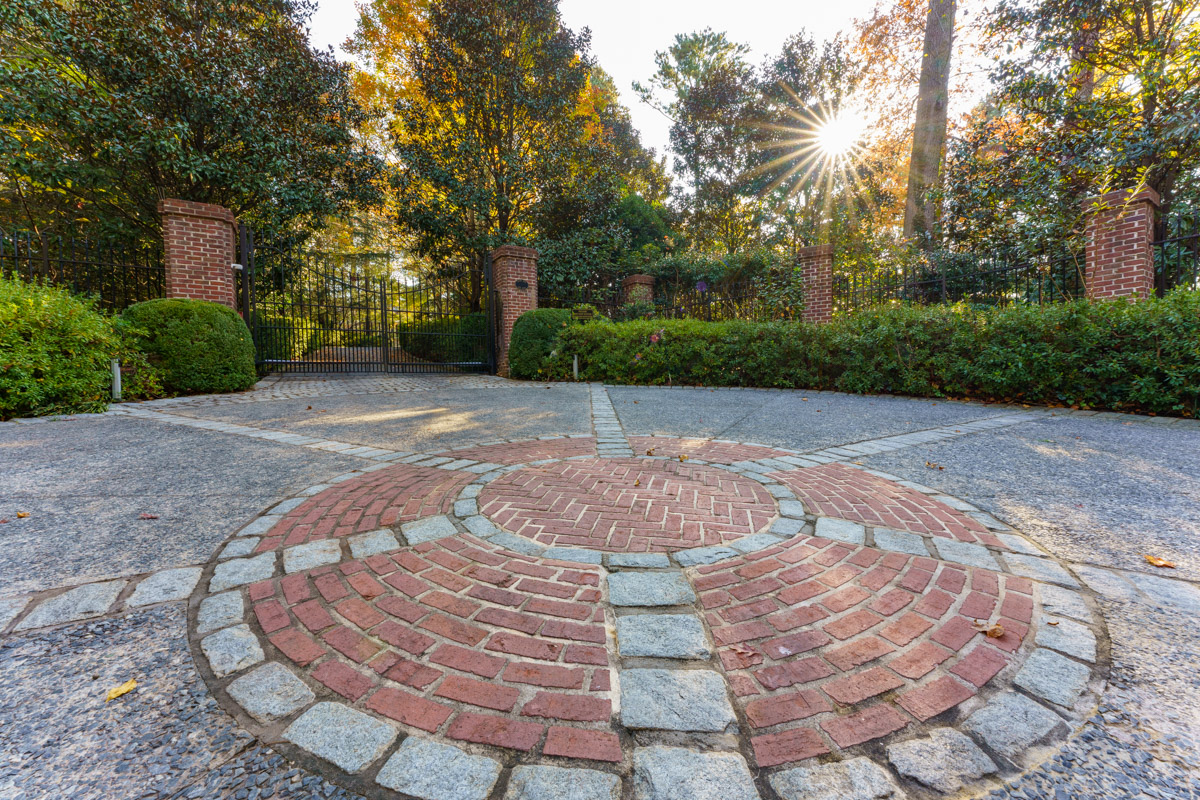
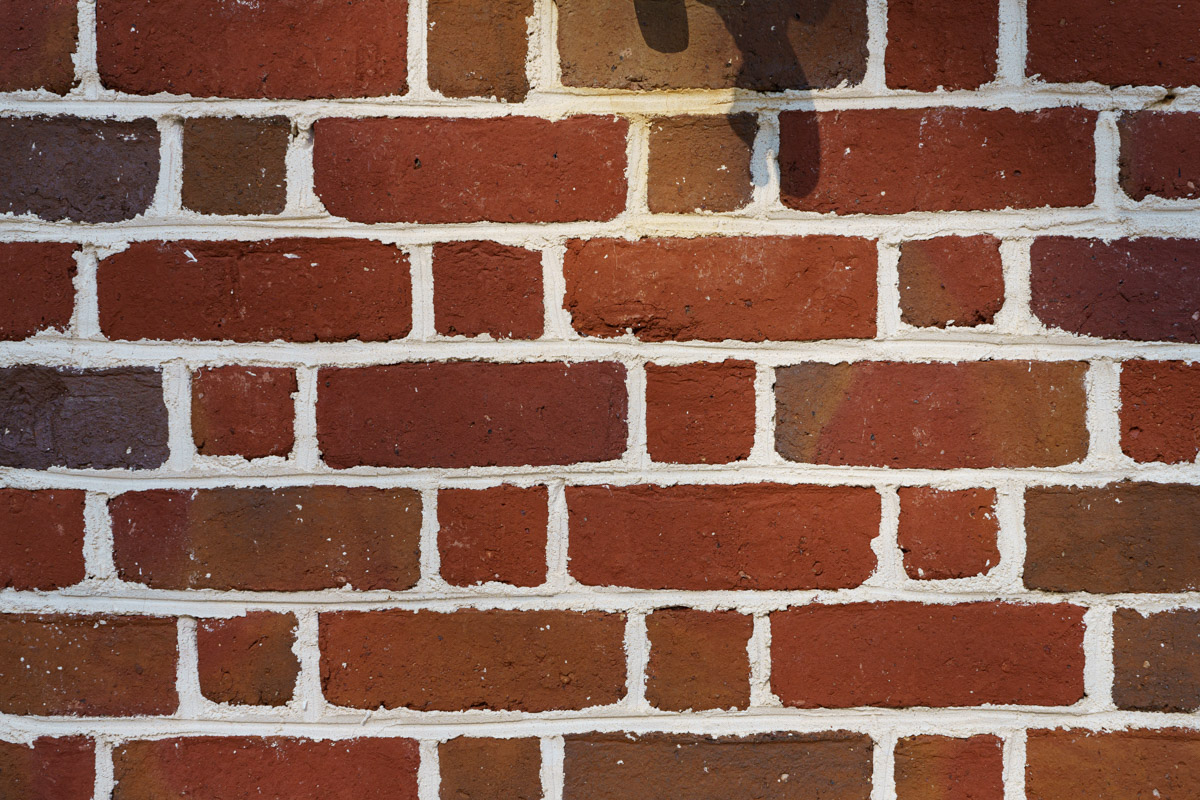
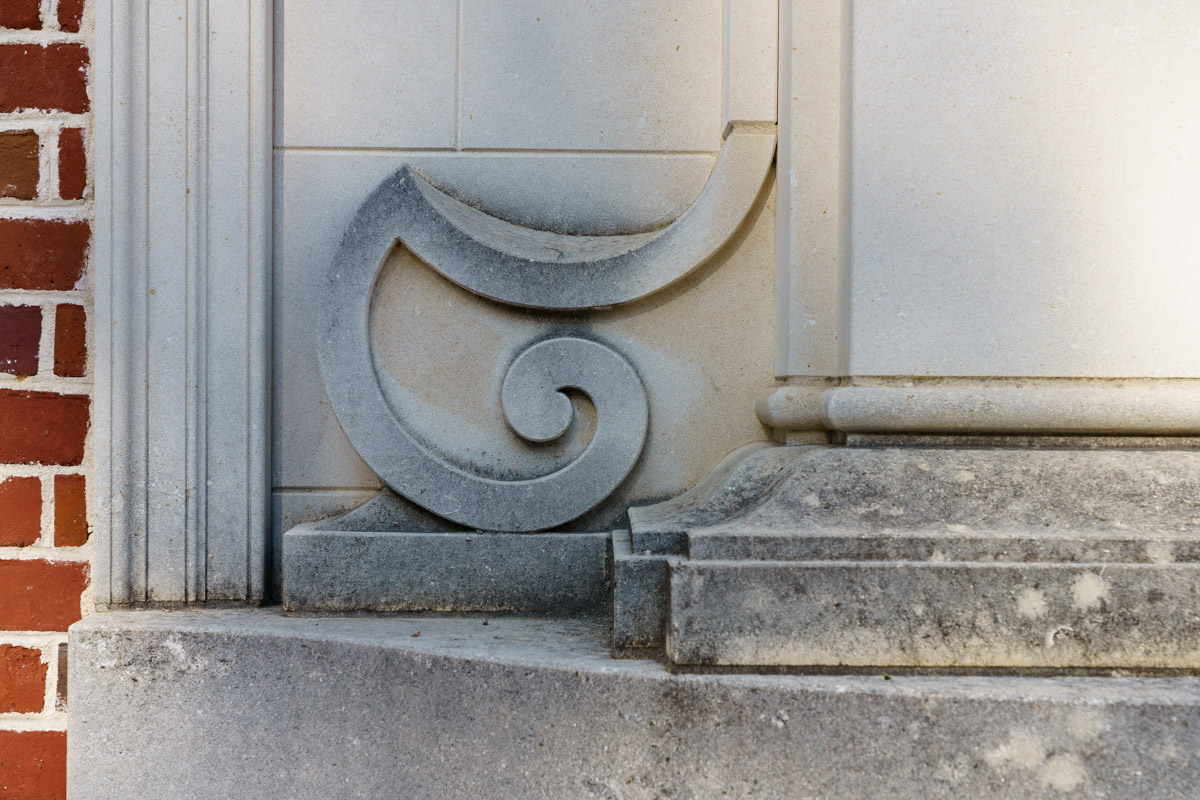
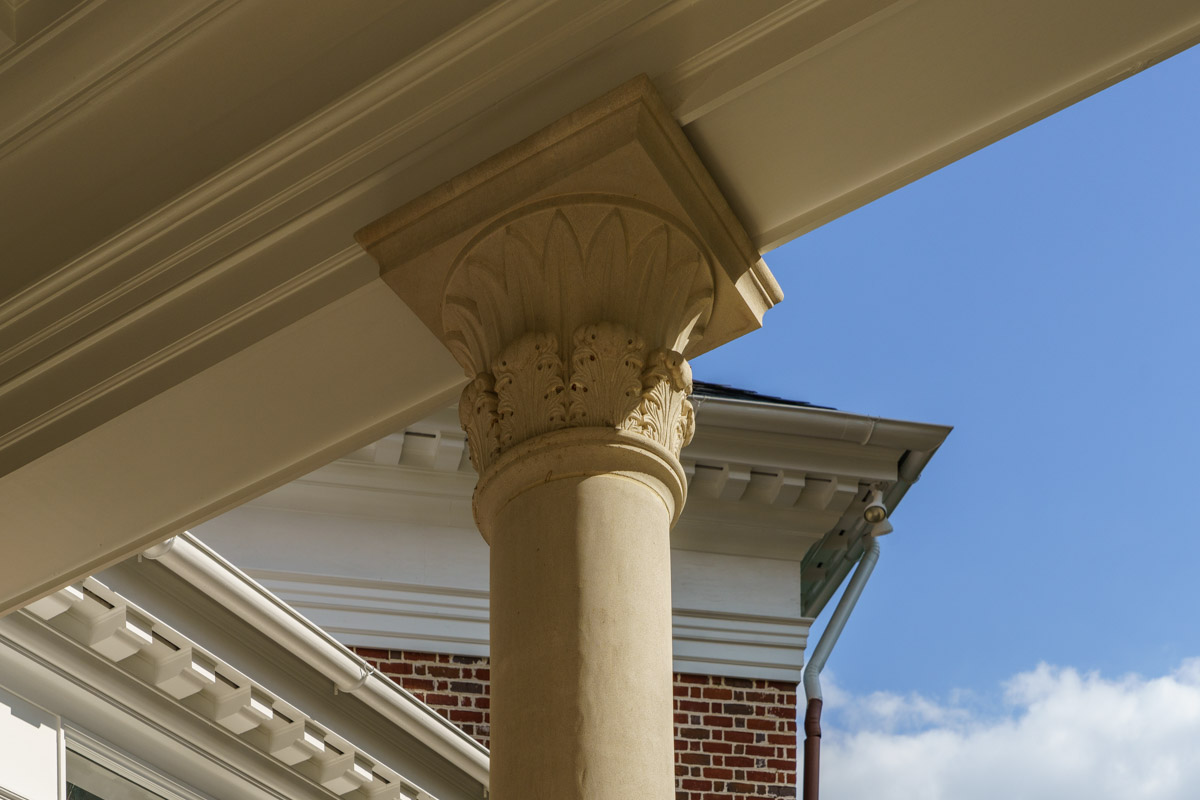

Inside, the massive rotunda soars 30 feet feet high and calls for a moment of reflection just to take it all in. A formal living room, banquet dining room, hidden bar, and paneled library radiate off of this central space that also flows seamlessly into the back gardens. This space was designed for entertaining and has served this purpose well!













Beyond the formal rooms is the family zone of the home where the kitchen, family room, an exercise room, and utility rooms are found. All principal rooms on the main floor feature 13-foot ceiling heights.




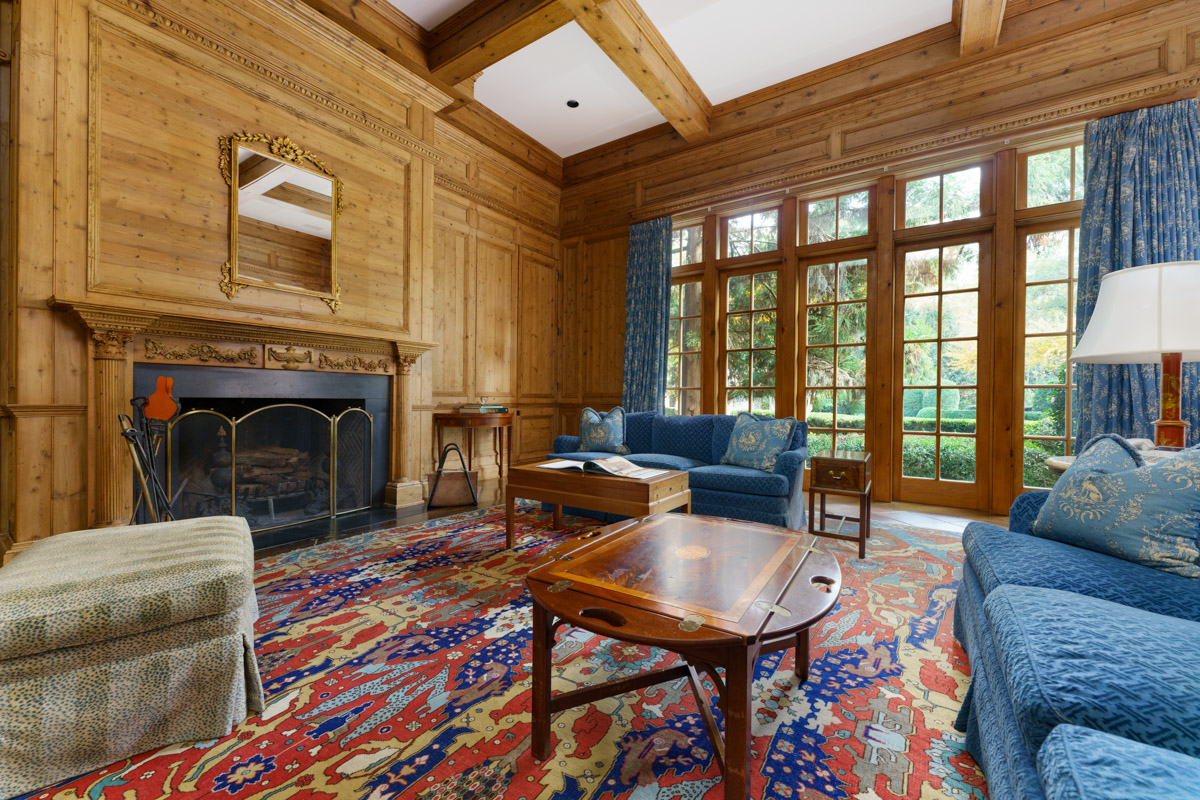

The owners suite occupies its own wing off the main rotunda. After passing through a large sitting room with a fireplace you enter the palatial bedroom area. Light streams in during the day from windows on both sides of the room. Separate his/hers bathrooms are connected by a shared shower and each has its own walk-in closet.






A sweeping grand staircase from the rotunda, as well as 2 smaller staircases on either side of the home access the four oversized guest suites on the 2nd level. There is also a media room and guest living room on this level.







Above the three-car attached garage is a 2-bedroom/2-bath guest apartment that can either be fully connected to the main home or locked off as a separate apartment.


The terrace level features several thousand square feet of unfinished storage areas that may be finished if more space is needed. The walkup 3rd-floor attic provides additional storage.
Georgia Power has plans to bury electric lines in several Buckhead neighborhoods starting this year as part of a multibillion-dollar plan to reduce blackouts. First, they need to secure the necessary easement by winning over property owners in the path of the project.
Buckhead’s impressive urban forest is a huge civic asset, but also means that storms – like the remnant of Hurricane Irma in 2017 – often topple trees into power lines. Burying – or “undergrounding” – the lines is a way to avoid that problem.
“Placing power lines underground makes the grid more resilient because they’re less vulnerable to storms and wind, but it’s not fault-proof,” said Georgia Power spokesperson Marie Bertot. “In areas prone to flooding, digging, root vegetation and other underground activity, it’s not always an option.”
Undergrounding is sometimes done for aesthetic reasons as well. But the Buckhead plan will leave existing poles standing to carry lines from the street to houses and businesses, and for use by telecommunications companies (AT&T, Comcast). According to one source, additional poles will actually be added to deal with the new web of connections. In rare cases where neither Georgia Power nor the telecommunications companies are using a power pole, it will be removed.
In addition, the underground system requires a series of transformers housed in familiar green metal boxes that will be installed in front yards and along sidewalks, so many residents will be hearing from Georgia Power contractors about purchasing easements for those devices.

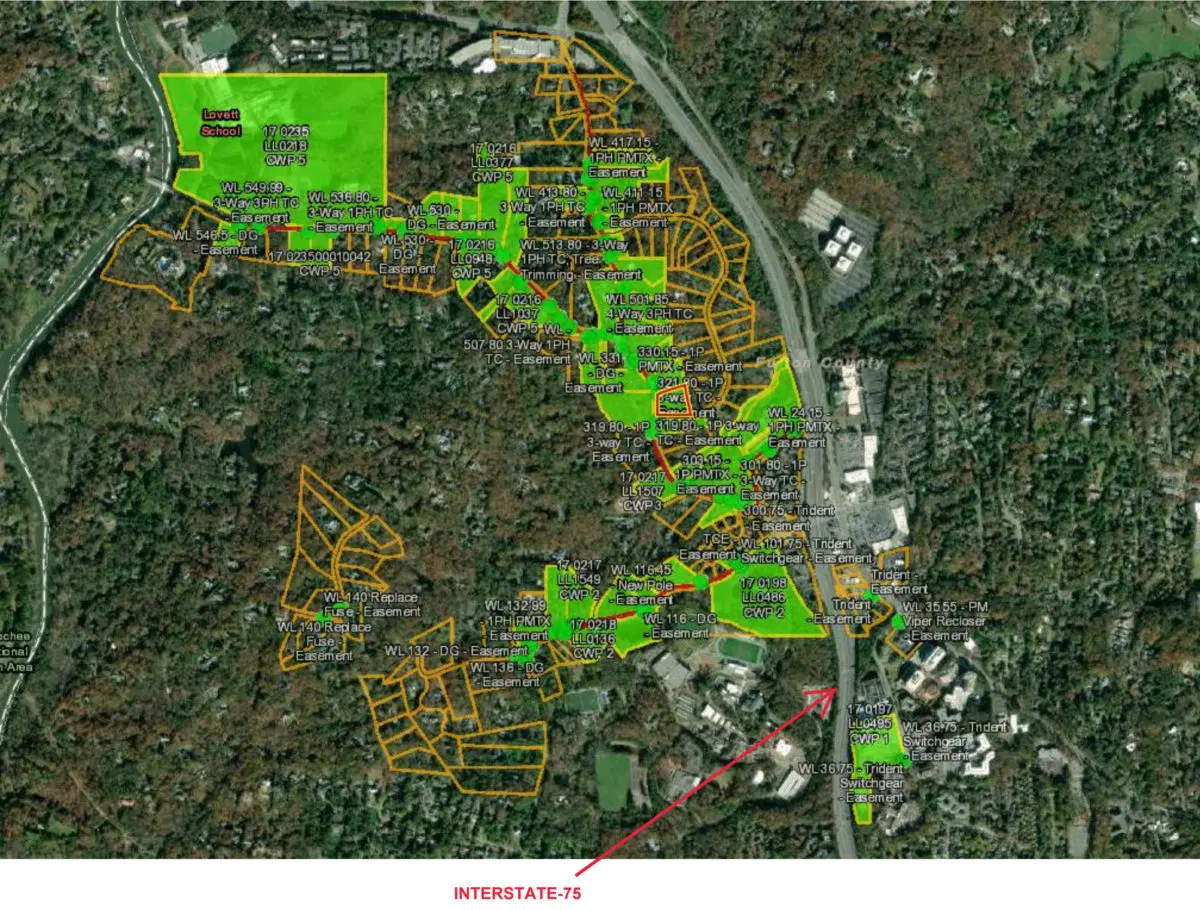


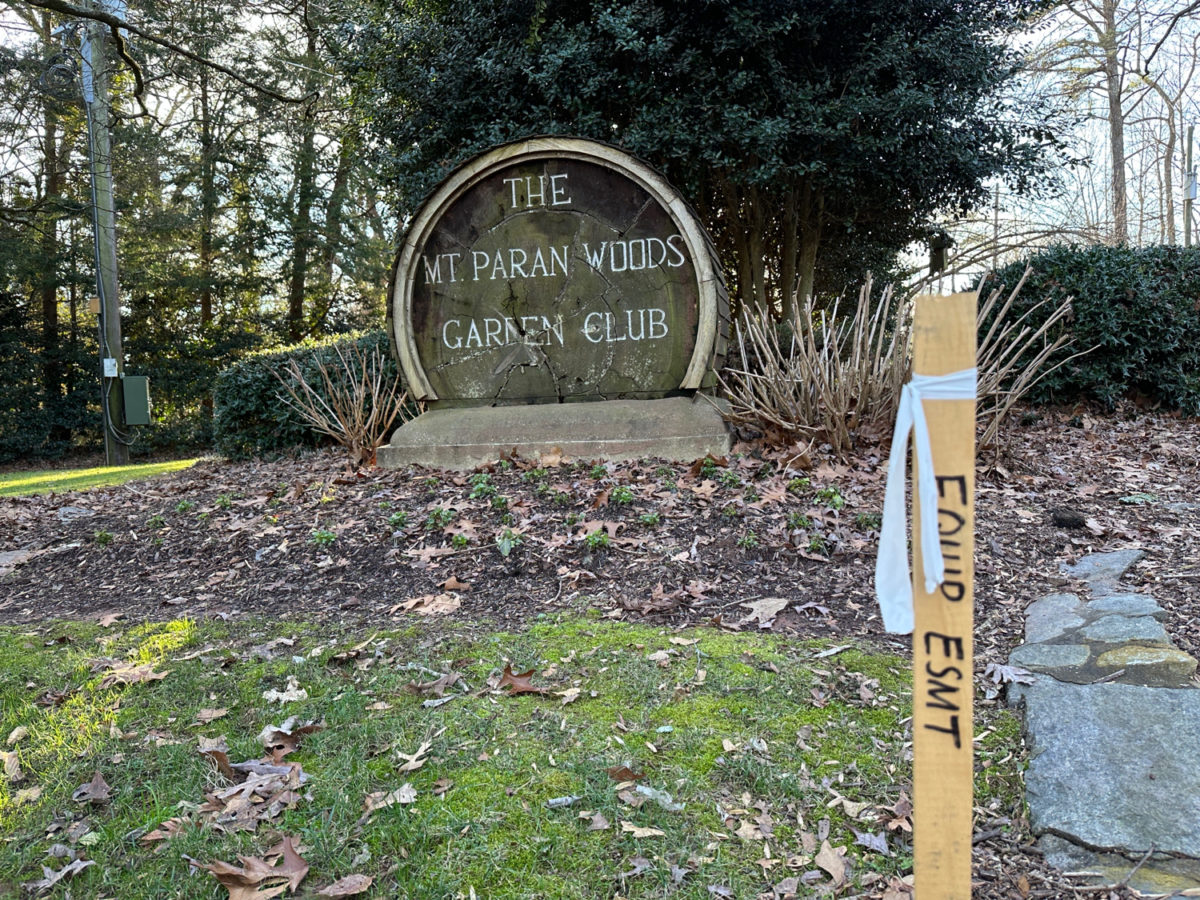
The local work will cover the Paces Ferry, West Paces Ferry, and Powers Ferry roads corridors in such western neighborhoods as Chastain Park, Paces and Tuxedo Park, as well as part of North Buckhead between Ivy and Wieuca roads. Georgia Power aims to begin construction this spring and summer, with the work lasting approximately 12 months.
The work is just one part of Georgia Power’s “Grid Investment Plan,” a major, multiyear project of systemwide improvements. The goals are improving the reliability of Georgia’s electric grid and lessening the impact of any failures. The company is about two years in the first phase, for which it is spending $1.3 billion.
Improvements are not performed randomly. “We are making strategic grid investments, selecting project locations based on historical service and performance data to ensure that we are putting our resources in the right places to improve reliability,” said Bertot.
The grid has two basic components: transmission, where power is sent over long distances to localities, and distribution, which is sending the electricity into your home or business.
On the transmission side, the plan includes replacing wires and/or structures, and substation improvements as significant as full reconstruction.
On the distribution side, undergrounding is just one of several improvement tactics. Others include: adding “automated line devices” that automatically isolate outages to smaller parts of the grid; adding connections, which can provide a backup power source; relocating lines in hard-to-reach areas so that repairs are easier; and line strengthening, which can refer to a variety of upgrades in localized spots that make damage or other failures less likely.
Buckhead is also getting automated line devices and strengthened poles, according to Georgia Power.
Many other neighborhoods, such as Druid Hills, are getting similar improvements, including undergrounding.
Undergrounding requires various metal boxes to be set into the ground to provide power switching and delivery. In particular, a box called a “single phase transformer” has to be placed “every few homes” for delivery, according to Georgia Power’s website. Those are green boxes on a concrete pad that are roughly 26 inches high, 34 inches long and 31 inches wide. They are built on a concrete pad and need about 10 feet of clearance to be maintained on all sides.
There is not sufficient space for the boxes to be installed in the public right of way, which in residential areas typically means a narrow strip of lawn along the road. Acquisition subcontractors are now contacting residents seeking easements to install the devices, offering around $1,000 as compensation. If the initial offer is rejected, the offer escalates quickly and significant amounts have been reported.

The easements are all voluntary, according to Georgia Power, though it is less clear what happens if property owners refuse, especially on an entire street. The company’s answer is that in such cases it would “explore other project alternatives.”
The company says it aims for “minimal disruption” in installing such devices. But the work might require trimming trees, removing landscaping and digging up sidewalks and road trenching. Landscaping and sidewalks would be replaced by the company.
The undergrounding affects only the main distribution line, not the lines going to individual properties, so poles will remain for that purpose. Georgia Power also says it notifies telecommunications companies that may also use the poles about the work, but can’t control whether they also choose to bury lines. Any pole used purely for carrying a Georgia Power distribution line would be removed after the undergrounding.
Georgia Power provides extensive information about the Grid Improvement Plan – including frequently asked questions and construction maps – on its website.
The following are the general areas and timelines for undergrounding of lines in Buckhead, according to Georgia Power. All of the general areas include “most side streets in the area.”
This lovely gated mid-rise condo community close to everything – shopping, restaurants, medical facilities, schools, Corso, The William Breman Jewish Home and more.






Two bedroom 2 bath condo with a cozy fireplace and balcony off main living and primary bedroom. The freshly painted living/dining space is open to the nicely appointed kitchen with cherry wood cabinets, a gas stove and lots of storage and counter space.







Tucked away off Howell Mill Rd close to Northside Pkwy, this boutique community has all the amenities – a large swimming pool with hot tub, fitness room, club room with catering kitchen, secured parking garage, concierge, tons of guest parking, fountains and a large grassy area for dogs. The unit has 2 deeded parking spaces + a separate nice-size secure storage room.






The Brandon neighborhood is a prime example of big-city conveniences and private suburban atmosphere Buckhead is known for. Walk to Memorial Park, Bobby Jones Golf Course/Bitsy Grant Tennis Center/Boone’s Restaurant, the BeltLine, or through the gorgeous surrounding neighborhoods. The neighborhood serves as a hub of activity, with privacy for residents living off the main streets.


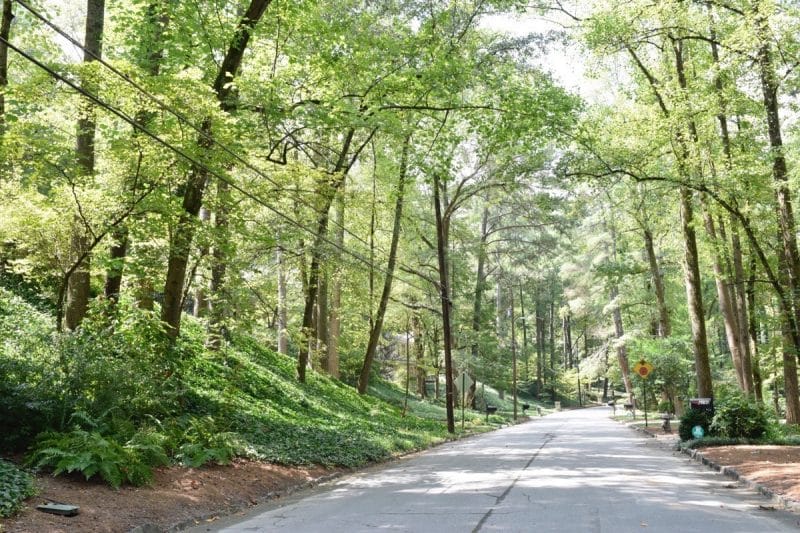
Classic Buckhead landmarks like the Arthur Blank Family Foundation, Atlanta Girls’ School, Junior League Atlanta, the popular Carl E. Sanders YMCA, and more occupy this neighborhood. In addition, a variety of churches, which include Trinity Presbyterian, St. Anne’s Episcopal and St. Luke’s Lutheran Church, make steeples abundant. In addition to top-ranked public schools, there are many private school options in and near the Brandon neighborhood.
Tech billionaire Tope Awotona, founder of the scheduling software company Calendly, is preparing to settle into Buckhead with a new West Paces Ferry Road home under construction. The home is so large that two lots were purchased to accommodate it.
Awotona – who did not respond to an interview request – is among the neighborhood’s several billionaires, including Spanx clothing founder Sara Blakely and Mailchimp creator Ben Chestnut.
Awotona made Forbes magazine’s list of billionaires at age 40 this year, with Calendly’s estimated value at $3 billion less than a decade after he launched it with the help of Buckhead’s Atlanta Tech Village. When Calendly had reached a viable product, Buckhead investor David Cummings stepped in with a $550,000 seed round that later took off.
He was born in Lagos, Nigeria to an entrepreneurial family, according to an Inc.com profile: his grandmother had a textile business, his mother and aunt co-owned a pharmacy, and his father left a corporate job to start several businesses. When he was 12, his father was shot to death in a carjacking, in front of him. “There was a part of me, from a very early age, that wanted to redeem him,” he once said told Forbes. The family left Nigeria for Marietta Georgia in 1996, when was 15.
Awotona was precocious, graduating high school two years earlier and accepted into college at age 15, though his mother would not allow him to attend at that time. He went on to graduate from the University of Georgia and went into software sales.
But the startup urge had a hold on him, and he launched a string of unsuccessful businesses: a dating site and ecommerce sites for projectors and yard equipment.
In 2012, while attempting to schedule a meeting, Awotona realized there was not a good product for doing so smoothly and quickly. That gave him the brainstorm for Calendly, which he launched in September 2013 and soon brought to Atlanta Tech Village, a startup incubator on Piedmont Road in Buckhead, which helped him to secure funding.
Today, the business remains based in Atlanta, though it has no physical office, with everyone working remotely as of last year. Forbes estimates it has 10 million users in a rapidly growing base. Awotona remains the majority owner and works as CEO.
The spectacular success of Calendly has made Awotona wealthy – but one of only two Black tech billionaires in the U.S., by Forbes’ count.
“Your background is what you make of it. It can be an asset or an excuse,” he told Tech Village in a 2018 interview. “I have never accepted lowered standards. Where I grew up, everyone looked like me – all of our leaders were Black, so color didn’t set any limits to my dreaming. But I have learned that growing up Black in America is very different. There are not nearly enough examples of people who look like us in positions of power or who have a lot of success in the tech field. Unfortunately, that limits people and can hinder the idea that they can do whatever they want.” Now, Tope Awotona is a role model to others that shows what is possible, regardless of race.
According to Calendly and various media profiles, Awotona also maintains a residence in New York City and enjoys standup comedy, CrossFit exercise and meditation.
Buckhead’s historic Whispering Pines mansion, the subject of recent preservation talks with a developer, has been half-demolished in a surprise move following an abrupt sale of the property.
“I am just sick,” said City Councilmember Mary Norwood of Buckhead’s District 8, who had been involved in the preservation talks.
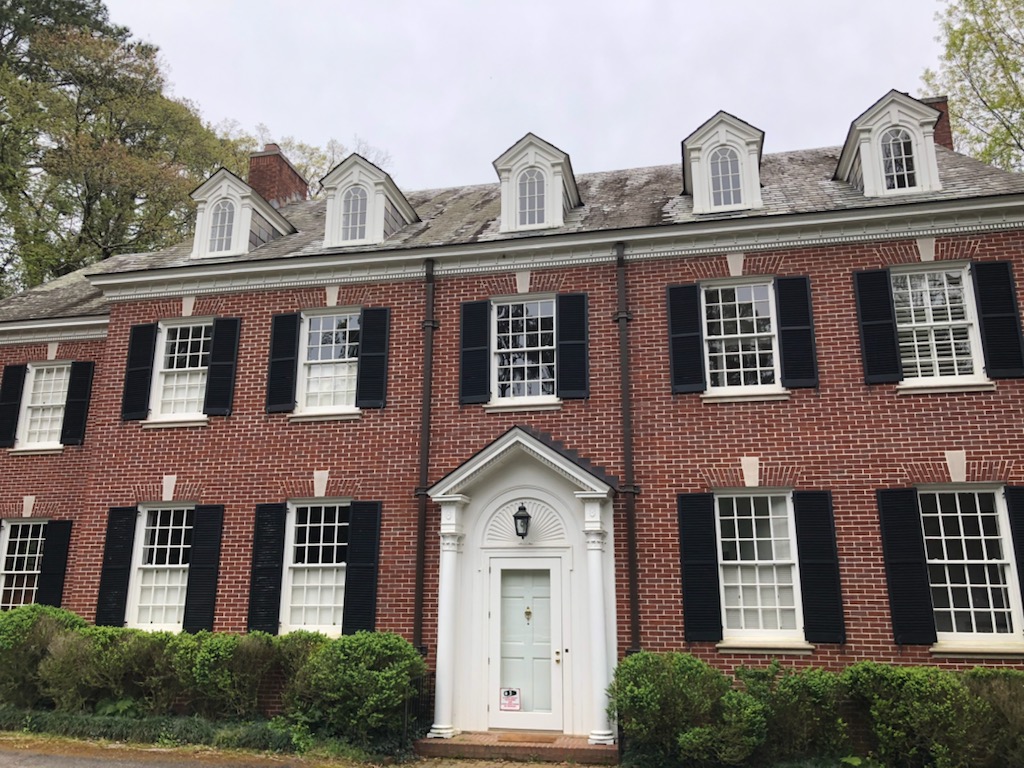
Dating to 1928, the mansion at 660 West Paces Ferry Road was among two-dozen estates that created the West Paces Ferry-Northside neighborhood. Its demolition began Aug. 23 but was halted by a stop-work order issued by City inspectors. Half of the facade was already gone, with rooms open to the air, ducts and timbers dangling, and the remains of a slate roof slumping.
“It’s terrible,” said Norwood. “We are losing one of the first houses ever [in that neighborhood]….” We just have not done that ever on West Paces Ferry, but we are now.”
A neighboring house at 670 West Paces Ferry, which also was historic and an element of the redevelopment plan, was already demolished by the crew in recent days, leaving a blank area of earth. That house dated to the 1950s.
The larger West Paces Ferry corridor began development around 1910. Other historic houses have been lost over the years, including at what is now the Georgia Governor’s Mansion in Tuxedo Park, and the recent demolition of such newer structures as a 1940s mansion at 274 West Paces Ferry.
The Macallan Group was the developer who acquired both properties around two years ago as part of a 11-acre assemblage with the goal of creating a new residential subdivision. Various neighborhood groups, community leaders and preservationists negotiated with Macallan on reducing the density of the project and finding a way to save Whispering Pines.
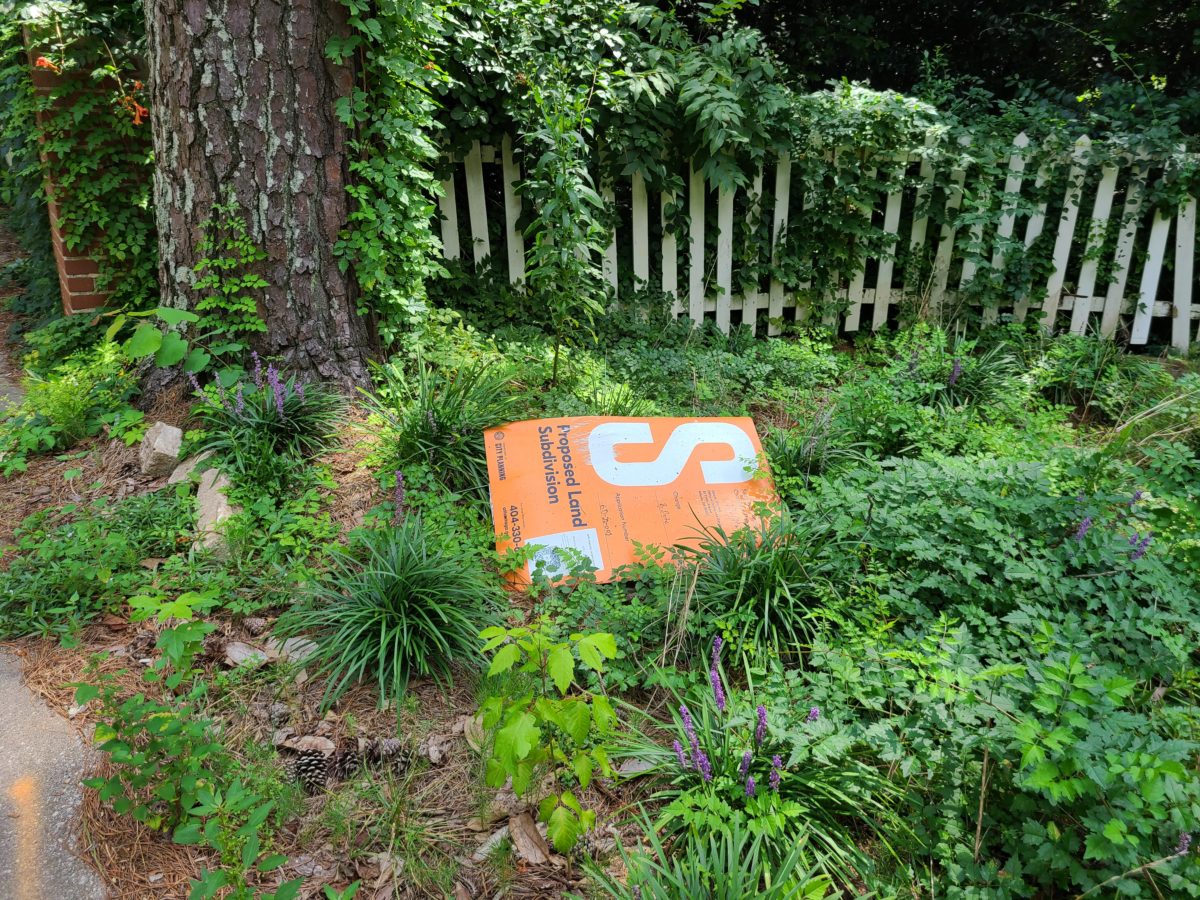
Apparently unbeknownst to those advocates, Macallan in May applied for a demolition permit for Whispering Pines. City records show the permit was issued.
When Buckhead.com visited the site Aug. 23, two City officials were leaving. The demo crew said they were inspectors who had just issued a stop-work order, without explaining why. Norwood had visited the site along with them, the crew said. The Department of City Planning later confirmed the stop-work order and indicated it was related to the unannounced ownership change. A complaint record shows the concern was that the demolition permit had been issued “without pre-inspection for demolition approval” and without approval from the Atlanta Urban Design Commission.
The demo crew said that Macallan still owns the property. But property records show 660 and 670 West Paces Ferry sold Aug. 8 for around $8,968,954 total to a newly formed, Athens-based limited liability company called Westlake WPF Holding. But City records do not show the LLC or anyone else filing permits or plans for 660 West Paces Ferry.
Macallan did not immediately respond to a comment request. An Athens attorney who is the LLC’s registered agent could not immediately be reached for comment.
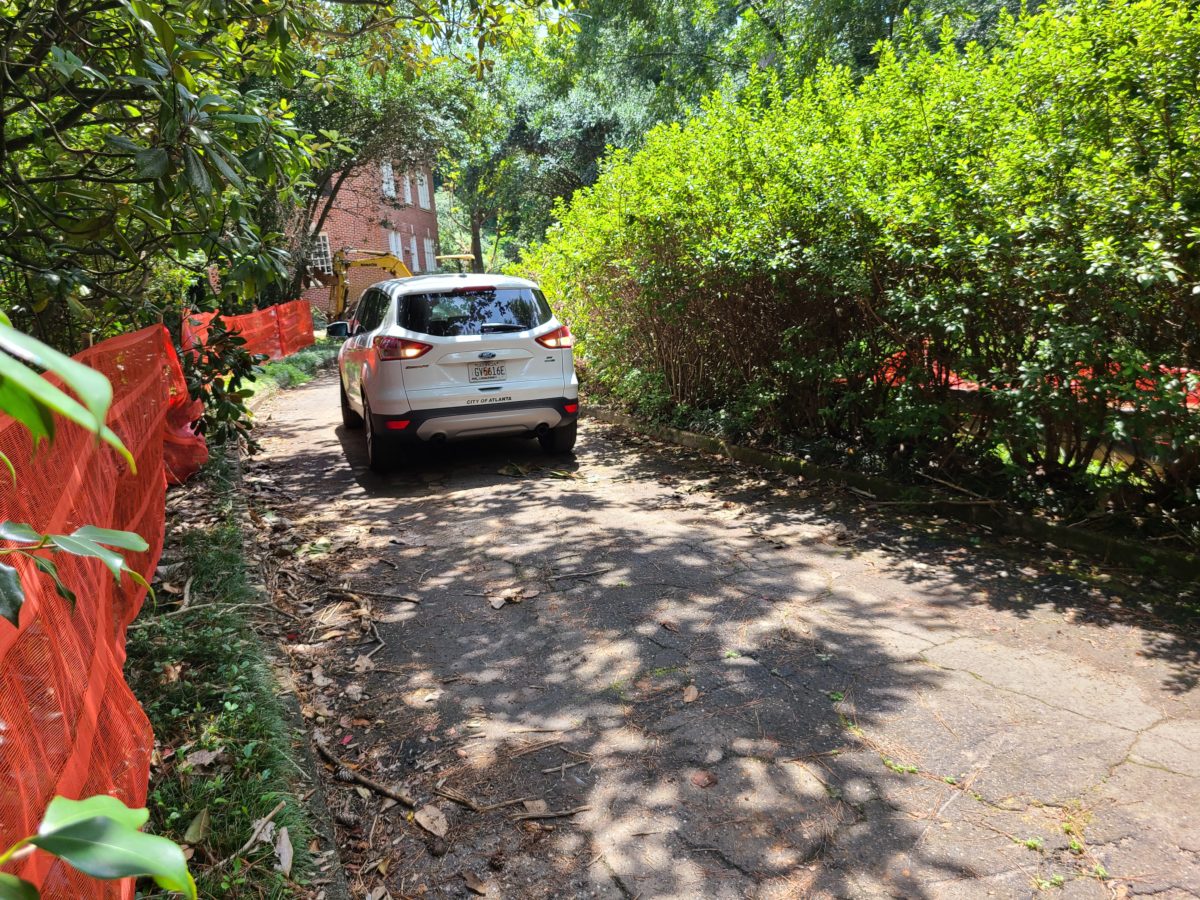
Macallan’s sales announcement, sent via email Aug. 22, is supported by commercial real estate sites that report the 660 and 670 properties were sold Aug. 8 for roughly $5.7 million in total.
“I am writing to let you know that The Macallan Group sold the 11 acres that we acquired at West Paces and Northside Drive and we will no longer be involved with this property going forward,” wrote Macallan co-founder and managing partner Mike Minutelli, which was sent via email Aug. 22. He did not name the buyer or their plan for the site.
“The Macallan Group believes that the sale of the property will provide a fresh look at different development options for this site, and they look forward to seeing how the land will ultimately be developed in the future,” he wrote.
The nonprofit Atlanta Preservation Center (APC) was the lead in providing historic expertise in the negotiations to save Whispering Pines. In a written statement, APC Executive Director David Yoakley Mitchell expressed gratitude for the process and praised the work of Norwood, Neighborhood Planning Unit A, the West Paces Neighborhood Association and Macallan.
“While we sought to see an alternative outcome to this process, we know that we dedicated every resource and recommendation to this effort,” Mitchell wrote. “… Our hope is that the loss of this home will encourage all of Atltana’s communities to reevaluate historic preservation and embrace its opportunities.”
Mitchell told Buckhead.com that it would be “challenging” to salvage any artifacts from the now half-demolished structure and that the goal was preserving the building. He said the demolition “serves as a metaphor for what we need to be proactive about, which is growing the role of historic preservation.”
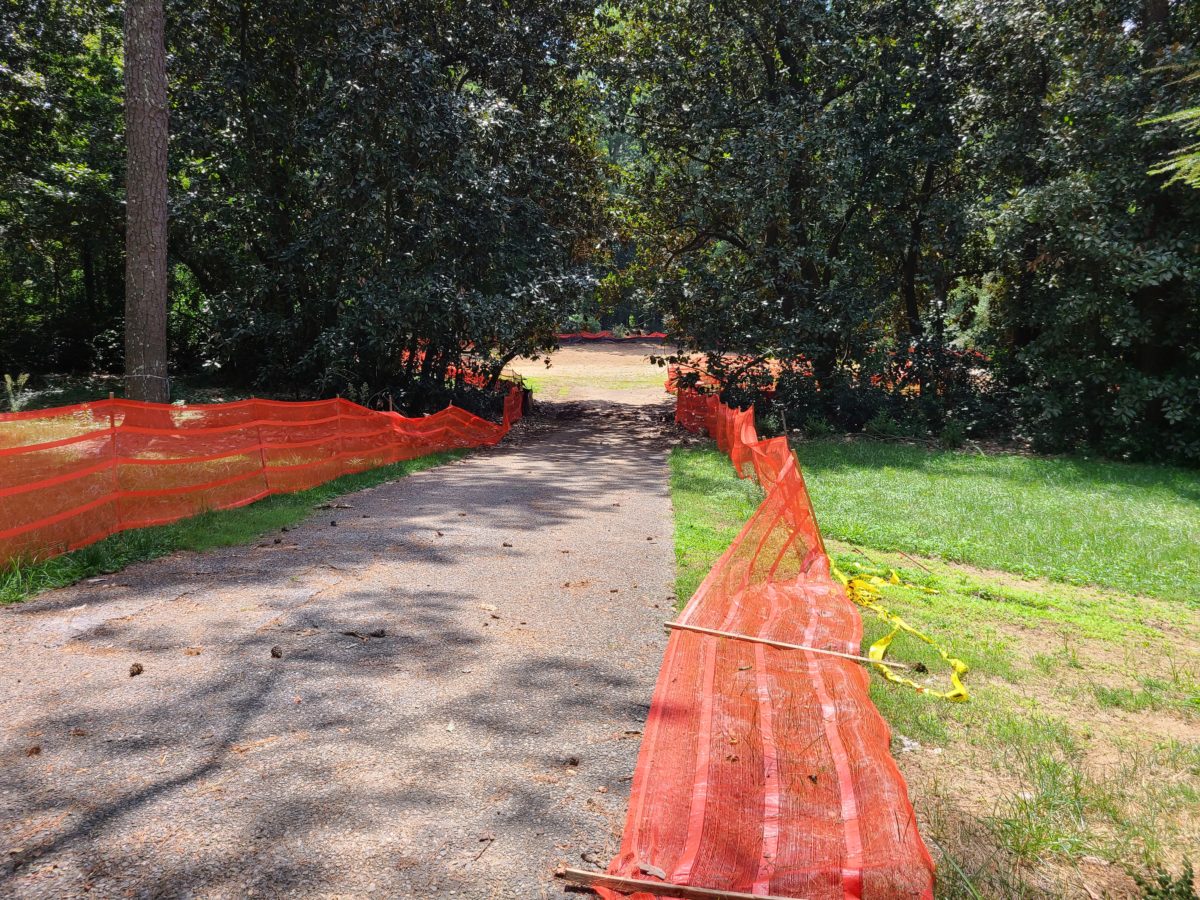
The house at 670 West Paces Ferry, known as the Nunnally House or Harrison House, also was historic, dating back 70 years, though that made it a relative newcomer to the neighborhood. The Nunnally House was rarely mentioned in news reports about the Macallan negotiations, as journalists did not independently examine the plan and advocates quietly accepted its demolition as a sacrificial lamb to save Whispering Pines. (A different house on Blackland Road is also known as the Nunnally House.)
“When given the complexity of the situation, we had to focus on what was the most [historically] contributing structure of the two to the West Paces Ferry corridor,” Mitchell told Buckhead.com. “It doesn’t mean one’s lesser or greater. It just means this felt like the path we felt the most strength in pursuing.”
Now both houses are on their way to being erased from Atlanta’s history forever.
Update: This story has been updated with stop-work order information from the Department of City Planning and information about other historic house demolitions.
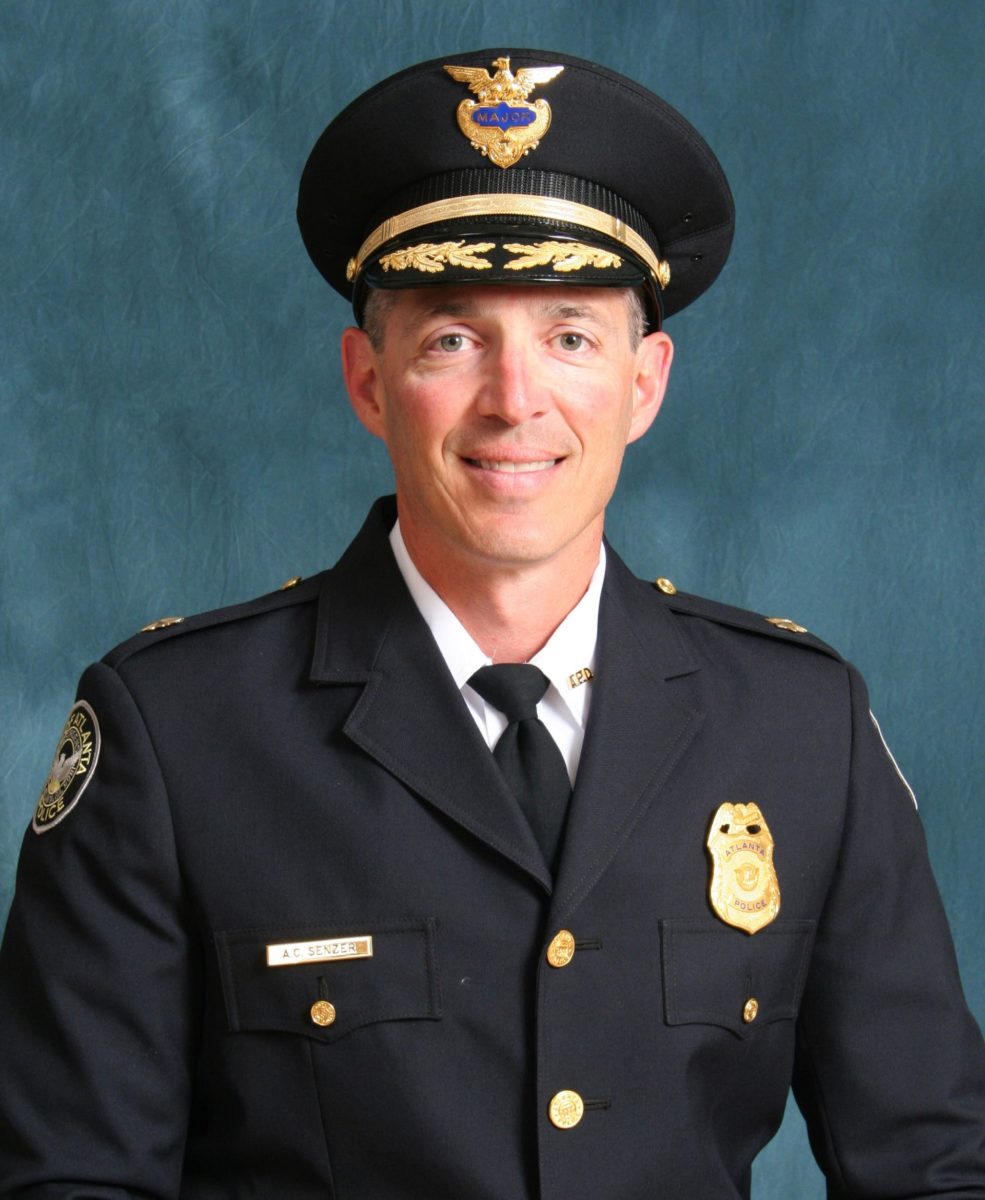
Buckhead’s Atlanta Police Department precinct is seeing a changing of the guard as its current commander has received a promotion to deputy chief.
Andrew Senzer, who has led the Zone 2 precinct since November 2019 with the rank of major, will head APD’s Strategy and Special Projects Division, he announced at an April 7 meeting of the Buckhead Public Safety Task Force.
Major Ailen Mitchell, who has served as Senzer’s assistant since 2020, will be the new Zone 2 commander, Deputy Chief Timothy Peek said in the meeting.
The transition will happen on April 14, according to APD. The current head of the Strategy and Special Projects Division, Deputy Chief Darin Schierbaum, is being promoted to the vacant position of assistant chief of police.
Senzer was Buckhead’s police commander through the historic COVID-19 pandemic and accompanying crime spike, including the May 2020 rioting and looting in local business areas that spun out of Black Lives Matter protests about the Minneapolis police murder of George Floyd.
He also led through the beginning of the Buckhead cityhood movement that based itself on crime concerns. While crime spiked, Senzer took a zero-tolerance approach and Buckhead continues to have the city’s lowest crime rate.
“It really has been an honor to serve as the commander of Zone 2,” Senzer said in the task force meeting. “In my 26 years [in policing], this has probably been the most challenging assignment I’ve had.”
He said his new role will be “a little behind the scenes” but that he will “not be a stranger” in Buckhead.
Peek said APD is “ecstatic” about Senzer taking on the deputy chief role.
Mitchell, according to his APD biography, has been with the department since 2006. He previously commanded the SWAT team and, like Senzer, once served on the Red Dog unit, an anti-drug squad disbanded in 2011 after controversial incidents like an illegal raid on the Atlanta Eagle gay bar. Among his other work was the Gang Unit and the Auto Theft Task Force.
Mitchell became Zone 2’s Criminal Investigations Unit commander in 2018 and its assistant commander in 2020.
Zone 2 is headquartered at 3120 Maple Drive in Buckhead Village.
Update: This story has been updated with information from APD about the transition.
Pala Bakery doesn’t feel like a satellite location for Antico, Gio’s Sicilian, or any of Giovanni Di Palma’s other restaurants. It has a unique personality that blends seamlessly with the Paces/ West Buckhead community. Di Palma & Son have created a bakery that feels like it has always been there, with unbelievable food and deep neighborhood roots.
This latest restaurant by Gio Di Palma is in the former Yogurtland location next to Wender & Roberts Drugs at West Paces Ferry Road and Northside Parkway. Gio made a name for himself in Atlanta over the past 13 years with authentic flavors and techniques have made him a household name when it comes to Italian food. Di Palma owns restaurants in West Midtown, Alpharetta, and the Battery at Truist Park, but Pala is his first restaurant in Buckhead. It’s also the first project Gio has undertaken with his son, Johnny Di Palma.


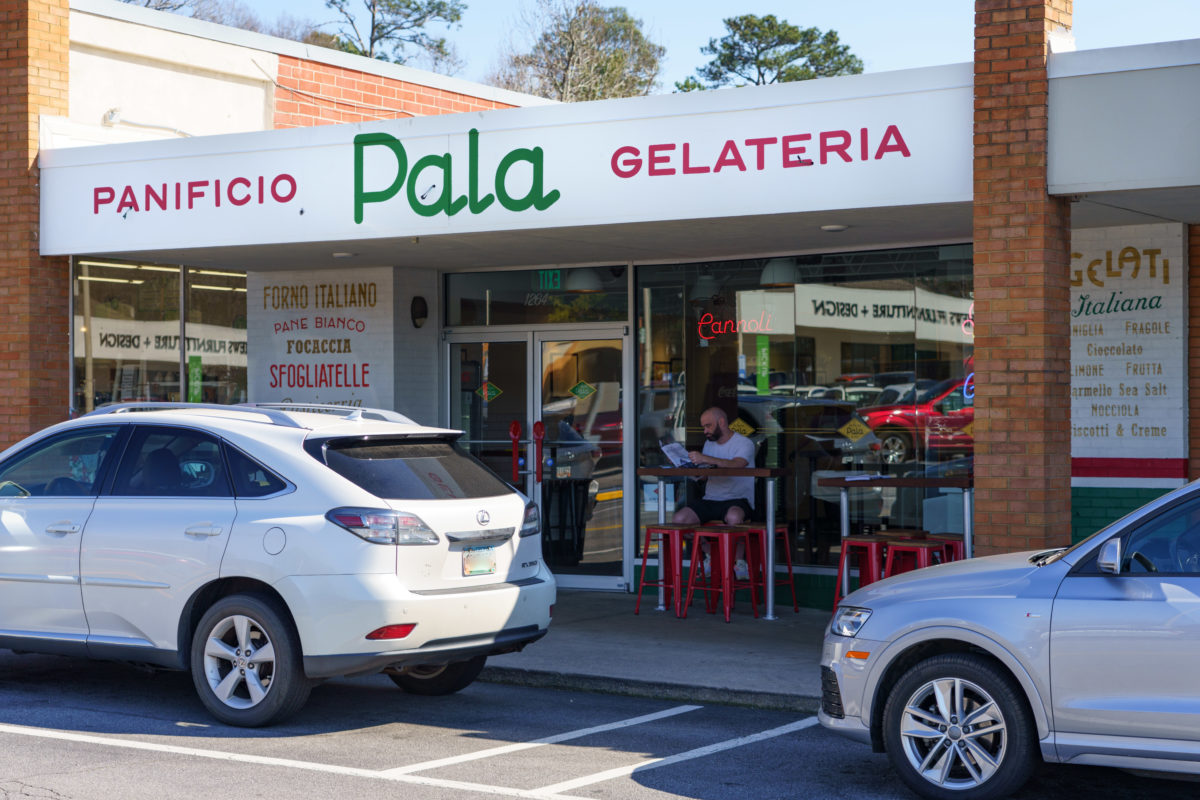

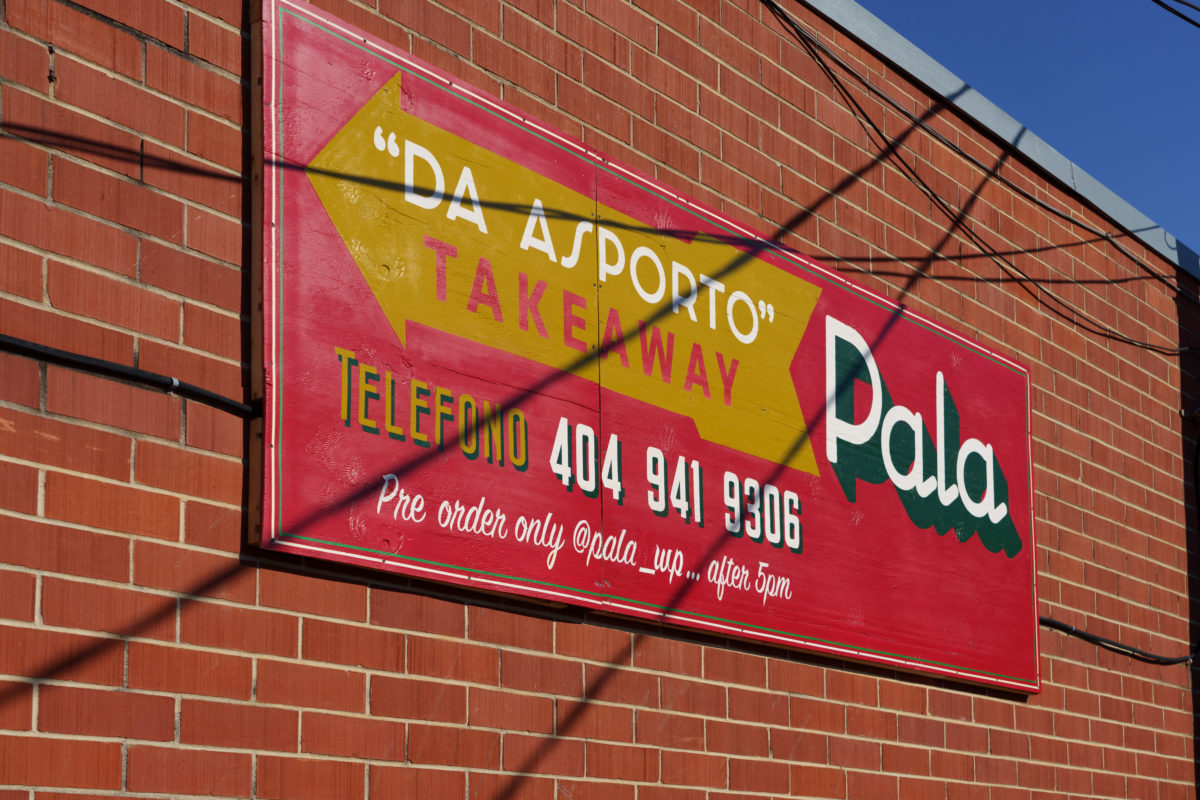

Gio has had his eye on Buckhead for a while. “We lived over here on West Wesley, and that’s where I learned about this area. I thought, ‘Man, if anything ever comes open in that place We’ll take it the next day.’ And we did.” He jumped at the first opportunity. “I don’t even think I even read the lease. I didn’t know what I was gonna do. I said, ‘We’ll, just take it. We’ll figure it out.'”
The former yogurt shop location wouldn’t accommodate another Antico or Gio’s Sicilian. The smaller space inspired Gio to build what he casually refers to as a “carry out place”. What he and Johnny have actually created is not a typical “carry-out place”, but a bakery and gelateria like the ones you would find in Rome, Italy. The bakery instantly feels like part of the neighborhood. You’ll find kids picking out their favorite gelato and folks ordering pizza and baked goods. Everyone seems to know each other, and most patrons understand that the food they’re getting is something special.

Giovanni is known for his Neapolitan pizza, and he says he still considers that the best in the world. But when he starts talking about the concept and the food at Pala, his passion for Roman-style pizza becomes clear. “In Rome it’s about the crust. Making Roman pizza is about being a baker.” Gio says as he motions to the sign on the wall that says “Sono solo un fornaio”; Italian for “I’m just a baker”. “Because no matter how successful I get, I’m just a baker.”
Those of us who have eaten Giovanni’s food know that he is definitely more than just a baker, but his passion for the art and craft of baking is clear. Gio described the 3-day process to create the dough for his Pinsa Romana and Pala Romana. Each step in the process is very specific, and he’s been working on it for years. Gio told me the Roman style crust is perfect for carry-out, “The end result is a crispy, light, airy, grab-and-go crust. Appearance-wise, it seems a little bit thick, but when you pick it up it’s all air. It travels really well and it delivers really well.”



At the counter, you’ll find small Pinsa Romana, and the larger Pala Romana. A Pala is the wooden “shovel” used to place and remove the pizzas from the oven. The Pala Romana is available whole, or by the cut. Remember, it’s not a slice, it’s a cut. You’ll find mouthwatering flavors like Calabrese, meatball & besciamella, and mushroom & artichoke, among others.



Giovanni conceived the flavor combinations and hand-picked the ingredients. As he described the menu, practically every ingredient he mentioned was imported from Italy, and each item specifically chosen for flavor and quality. His Castelli ovens from Rome are the same one’s they use at the famous Bonci Pizzarium.
There’s more to love than pizza at Pala Bakery. The doughnuts (“Joey bag-o doughnuts”) are authentic ciambella imported from Rome and finished in-house. You’ll also find home-made paninis, cornetti from Italy, and Fior di Zuca (fried zuchini) and Bacala direct from Rome. The Bacala and Fior di zuca are served in a paper cone with cocktail sauce, perfect to grab and eat on the go.


The gelato case at Pala is a dazzling array of colors and flavors that hypnotizes every kid who walks through the door, but Gio recommends something less obvious for adults with a sweet tooth. He’s looking forward to educating the neighborhood about soft serve gelato.



The vanilla soft serve gelato is delicious, but the toppings and flavor combinations speak to Gio’s creative talent. Even here, the ingredients are hand-picked and special. Olive oil and sea salt, with Coratina extra virgin olive oil that Gio has to “Pull some strings” to get from Italy. Pistachio cream and freshly chopped pistachios, both from Sicily.
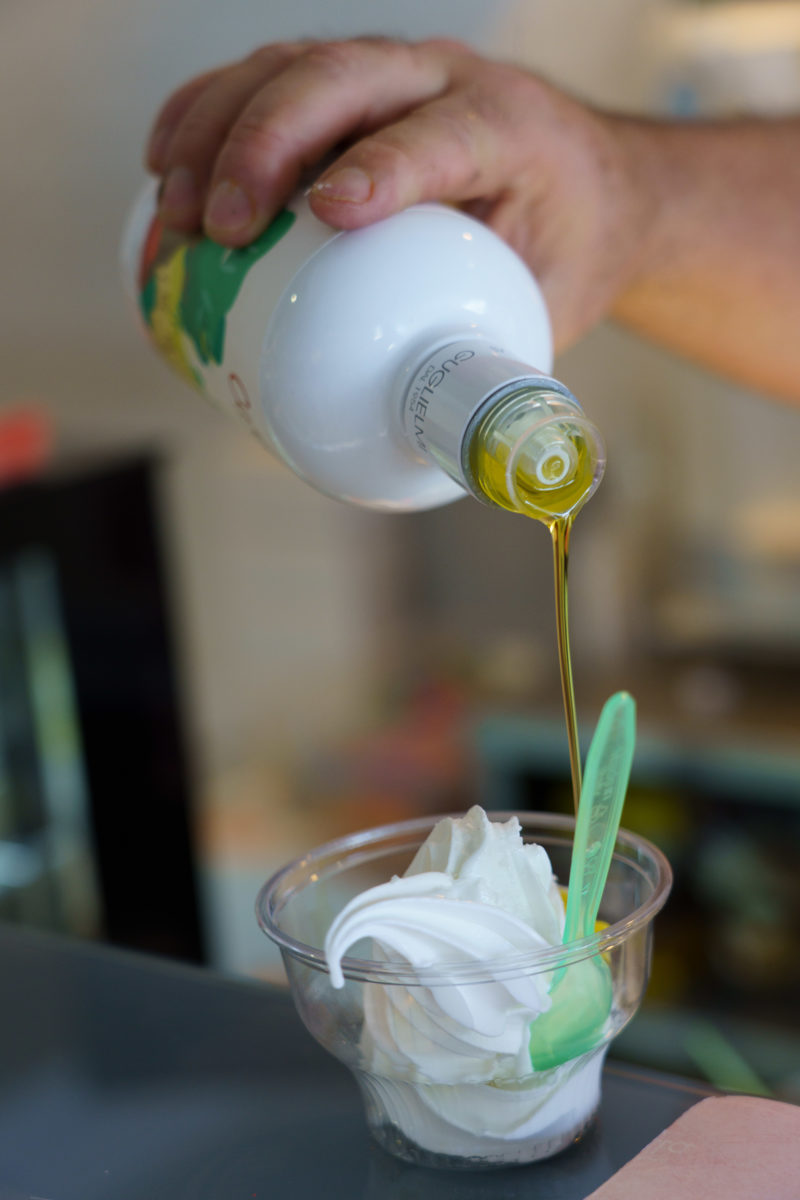

There is one soft serve gelato combination that Gio refers to as, “A problem”, because it’s so good it’s addictive. It’s rich vanilla soft serve gelato with crushed Georgia pecan pralines, drizzled with Pappy Van Winkle syrup. Bourbon drinkers will recognize the Pappy name from the famous small-batch spirits. Maple syrup aged in the used bourbon barrels is a unique flavor that is perfect with gelato and pecan pralines.

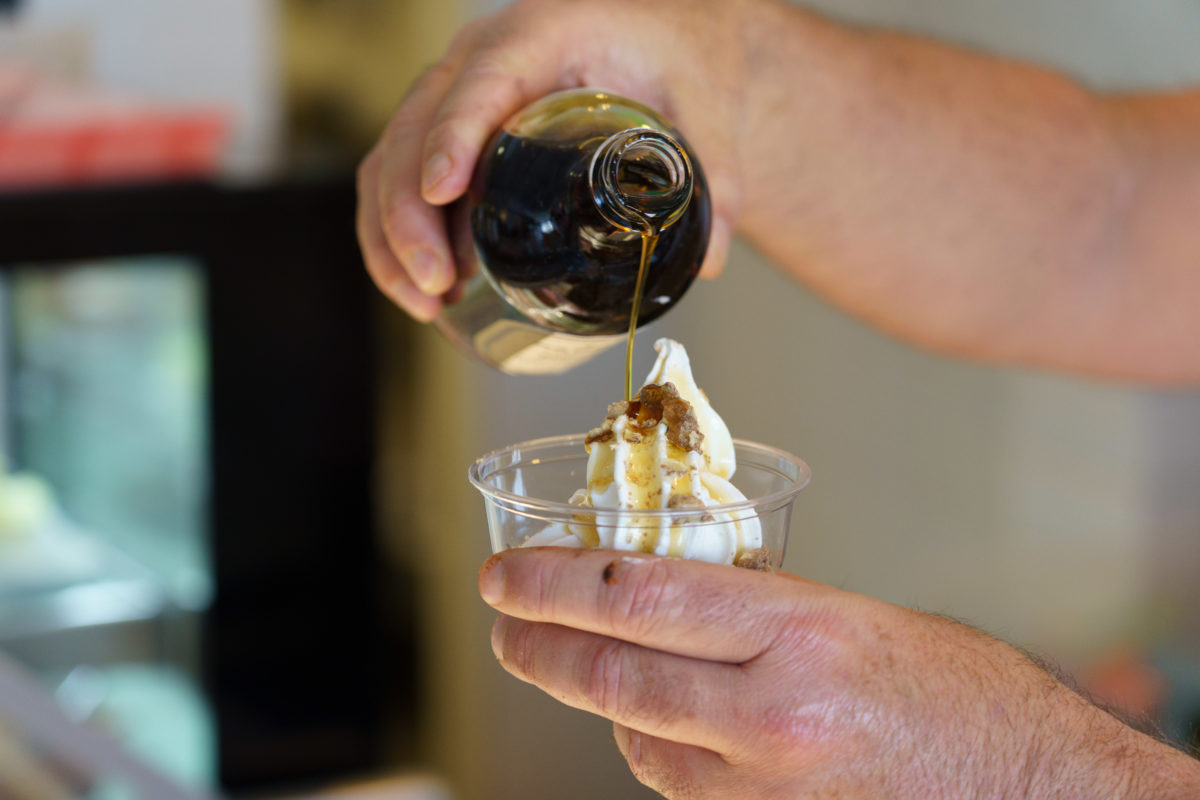
One of Pala’s first customers was an older gentleman who lives in Buckhead. A surgeon who is originally from Sicily. The doctor walked up to Gio and said, “I’ve been waiting 45 years for you!” He was so happy to find a neighborhood bakery like the ones he was used to back home in Italy. The doctor had a gelato, a coffee, “he bought everything!” This is exactly the authentic experience Gio and Johnny are going for.
Gio told me, “We’ve been in Buckhead for 13 years, and Johnny grew up in Buckhead.” Johnny played quarterback for Holy Spirit, and coaches soccer there today. Now Pala Bakery employs kids he grew up with, and other kids from the neighborhood. The Di Palmas are passionate about serving the community and providing opportunities for local high school and college-aged kids. “It’s amazing I’d never had a restaurant here, and now I’m like, ‘what was I thinking?’” Thanks Gio, we’re glad you changed your mind!
Visit PalaBakery.com to order online.
Nearly eight years have passed since an incurable killer of a beloved garden plant was first found in Georgia, lurking in a Buckhead lawn. Now boxwood blight has spread to devastate historic gardens and local landscapes across the country, while science is starting to catch up to the tricks of the fungal infection behind it.
Chris Hastings, owner of the Chamblee-based tree care firm Arbormedics, has been battling the blight in Buckhead gardens from Day One. He summed up the current state of affairs: “Is it bad? Yes. Has it gotten worse? Yes. Is it now commonplace on almost every street in Buckhead? Yes.”
However, Hastings adds, it also has not wiped out the plants as was originally feared. “But over all that time… it comes in waves,” he says, noting a particular blight-battling hint in its link to rainfall and moisture. “And really we’re still trying to figure out, what are those key moments? Because it’s not always as clear as you would expect.”
“The boxwood is such a beloved plant. It’s the aristocrat of the Southern garden.”
Chris Hastings, owner, Arbormedics
Jean Williams-Woodward is a University of Georgia Extension plant pathologist who was on the team that first identified the blight on boxwoods on that Buckhead property back in 2014. She says that “we’re still finding out things about this disease.”
The future she sees taking shape — much like the famously sculpture-friendly boxwood itself — is one where improved practices, disease-resistant breeds and a shift to other types of landscape plants will contain the blight.




Boxwood (Buxus sempervirens) is a type of small-leafed, evergreen plant native to Asia that for centuries has been popular nearly worldwide as an ornamental. In tree form, it makes for stately, pillar-like entrance ornaments. It also takes well to being shaped with trimmers and is hugely popular for rectangular hedges — which is how the plant got the “box” name. The English and American varieties are wildly popular cornerstones of the traditional Southern aristocratic garden.
“In the South… it’s a plant that tugs on your heart,” says Williams-Woodward. And on your purse-strings, too — for nurseries and landscapers, “It’s a huge economic impact.”
“The boxwood is such a beloved plant. It’s the aristocrat of the Southern garden,” said Hastings, adding that’s why homeowners are willing to battle the blight instead of just getting replacement plants. “It’s been used for hundreds of years here. It’s been tied in people’s minds and their sensibilities to what a gorgeous Southern garden looks like. So it’s very hard to contemplate having a holly instead.”
This pretty picture started going bad with the original discovery of boxwood blight in the United Kingdom in the 1990s. An American infection was just a matter of time, and in 2011, the first U.S. cases were found in Connecticut and North Carolina nurseries. A Virginia nursery was the likely source of infected plants that led to that first known Georgia case in Buckhead in July 2014, on a private property that the experts won’t publicly identify for privacy reasons. The blight may well have been elsewhere in Georgia already.
The blight has continued to spread around the country and has become a major pest in historic gardens. Colonial Williamsburg, the famous historic area in Virginia, has been battling the blight for over five years in its collection of more than 8,000 boxwoods, many dating back a century or more, according to media reports. In the past year, major boxwood culling was carried out at the historic homes of poet and author Carl Sandburg in North Carolina and 19th-century politician Henry Clay in Kentucky.
“I’ve seen very historic gardens where every single plant has been lost… They just look like bare stems,” said Williams-Woodward.
The blight is a species from a genus of plant-infecting fungi. It kills boxwoods by causing their leaves to die, and can infect the stems as well. The blight can also infect other plants in the same family, including pachysandra and sweet box, according to Williams-Woodward, but is often not so lethal to those species. Some varieties of boxwoods have a degree of resistance, but the beloved dwarf English and American cultivars are not among them.
The fungus spreads by sticky spores that spew off the plant into the environment. Once it infects a plant, there is no known cure.
Williams-Woodward says the fungus has probably been around for hundreds of years, but was less prone to kill boxwoods in their original native areas of today’s Asia and Turkey, where the climate is drier. Wetter conditions are among the factors that make the fungus thrive.


In the first decade of battling the U.S. blight, tactics have shifted along with research and field practice, and even now there is some disagreement among experts about how the fungus spreads and should be fought.
Hastings notes that the early U.S. discoveries were inside mid-Atlantic nurseries and greenhouses, with plants packed closely together. That led to some assumptions about how transmissible the fungus was and that the air might be a major transmission method for its spores.
“So I do think there was a little bit of a misunderstanding in the early days about how contagious it, how lethal it is,” said Hastings. “So a lot of the original reports that came out and still linger were like, ‘If you have boxwood blight on your property, tear them all up and run screaming for the hills.'”
Yet today, he says, some original boxwoods continue to survive on the original Buckhead property that was the first known to have the blight. He said a second Buckhead property where the blight was found in backyard plants at virtually the same time still has boxwoods, too, including some within 100 feet of those with the outbreak.
What everyone agrees on at the moment is that moisture is key to the blight’s spread and that the disease can be managed with multi-pronged tactics. The situation can be illustrated with imperfect analogies to more familiar human diseases. Think of the blight as a lethal version of athlete’s foot that, like that fungus, infects and spreads explosively in wet environments. And like the coronavirus behind COVID-19, experts can’t currently cure or eliminate the blight, but can contain and manage the disease through a combination of treatment, built-up resistances, avoidance and new, safer cultural practices.
The blight erupts when the weather is wet and temperatures are moderate, said Williams-Woodward. The symptoms may retreat in hotter and drier months, she said, giving plant-owners a false sense of relief while the incurable infection remains.
Water is also now believed to be one major way the fungus spreads, as splash-back from rain or irrigation droplets hits other nearby plants. “Spores produced [by the fungus] are very sticky and they cluster together,” said Williams-Woodward. “So this pathogen or disease is not something that blows around in the wind. It’s mostly water-splashed.”
Hastings agrees that water is a major factor, saying that the earlier wind-spreading explanation never matched what he saw in the field. “We do not see it marching through a garden,” he said, explaining that the blight is almost always paired with heavy moisture from the environment. He said he often finds it tied to a broken rain gutter or — especially in lawns of well-to-do Buckhead homeowners — irrigation systems that are overused when rainfall is perfectly adequate.
“Irrigation, irrigation, irrigation is the number one reason that people have [boxwood blight] problems in Buckhead,” he said. He won’t even take on a boxwood client who won’t properly manage an irrigation system.
“I think we will end up in some kind of combination of planting less-susceptible varieties, plus some cultural practices … So we can manage this disease.”
Jean Williams-Woodward, University of Georgia Extension plant pathologist
Research shows that animals and humans may also be carriers of the spores, says Williams-Woodward. Boxwoods “actually smell like cat pee,” she said, and so may attract cats and dogs to mark them, resulting in spores getting on their fur to be spread to other plants. She said she saw one garden where boxwoods were blighted at the same level as the cushion on a patio chair that a cat slept on. Squirrels, rabbits and turkeys are other suspected spreaders.
Landscape workers may also spread the spores on their hands and equipment, Williams-Woodward said. She is currently conducting experiments on easy ways for landscapers to disinfect their gear before traveling to another property. Regular Lysol spray is looking highly effective, she said.
Hastings doesn’t buy it. He says animals and humans pale in comparison to water and another form of Buckhead lawn epidemic — the use of high-powered leaf-blowers that could blast spores all over surrounding properties. “I don’t think we need to be caging our cats and spraying down our landscapers,” he said.
What about spraying the plants themselves? After all, you can knock out athlete’s foot pretty fast with a can of fungicide from the drug store. Turns out it’s not that simple for boxwood blight, and Hastings and Williams-Woodward agree it’s no main solution.
There are fungicide sprays that can effectively reduce blight symptoms in a plant, said Williams-Woodward. But it requires regularly repeated application that few landscapers or arborists will perform, and that can be cost-prohibitive and raises issues of environmental pollution. Overuse of the sprays also could lead to the evolution of fungicide-resistance strains of the blight, she said.
Hastings said he’s one of the few local arborists who will spray for boxwood blight, but only as part of an integrated approach, as he also has environmental and best-practices concerns.
“Do we put every boxwood in town on a chemical crutch? Absolutely not,” he said, again emphasizing moisture as the main problem. “The key to getting ahead of this is thinking about your basement getting mold or mildew… You don’t run in there and start spraying Clorox everywhere. … You get rid of the water source.”

Another option is blight-resistant varieties of boxwood. Some already exist and others are being cultivated. But a note of caution on some of those, such as Japanese and Korean varieties: Williams-Woodward said they may be less able to catch and die from the blight, but can still carry and spread it, making them “sort of a Trojan horse.”
Her preferred tactic is to simply replace smaller boxwoods with a totally different species, like Japanese holly, and to prune the lower branches of larger ones to avoid the water-splash effect that may spread the spores.
Hastings says he’s hopeful the boxwood blight battle eventually will take a similar course as brown patch, a different fungal infection that affects fescue grass lawns. He said that landscaping veterans have told him about the brown patch plague in the 1980s, which coincided with a boom in lawn irrigation systems. Initially, he says, there was similar advice to landscapers about attempting to disinfect mower blades and the like. Today, he said, brown patch is manageable in a coordinated program of lawn management techniques that continues to allow fescue to be planted.
Williams-Woodward also looks to a future of containment and management. She said research continues on exactly how the blight spreads, the environmental conditions that favor it, how its biology works, and arborist techniques. “I think we will end up in some kind of combination of planting less-susceptible varieties, plus some cultural practices … So we can manage this disease,” she said.
For more details about boxwood blight, see the websites of the UGA Extension and the Georgia Department of Agriculture.